Book Reviews (2016) by Joseph M. Sherlock
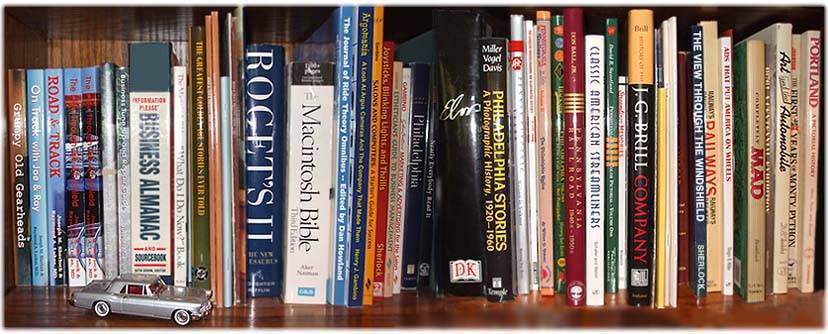
'The Field Of Flight: How We Can Win the Global War Against Radical Islam and Its Allies' by Lt. General Michael T. Flynn and Michael Ledeen
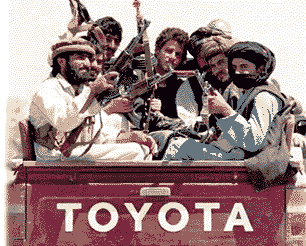 Less a memoir or autobiography, this book is a more of a call to action. It contains a multi-point plan to win the War on Terror. Lt. General Michael T. Flynn spent more than 33 years in Army intelligence and knows his subject. His forced retirement was because he refused to pretty-up the truth about terrorist threats and the safety of Americans. He has been selected as National Security Advisor for the Trump Administration. In this 208 page book, Flynn succinctly explains our failure to stop terrorism and recommends what must be done to fight and win to war on terror. Less a memoir or autobiography, this book is a more of a call to action. It contains a multi-point plan to win the War on Terror. Lt. General Michael T. Flynn spent more than 33 years in Army intelligence and knows his subject. His forced retirement was because he refused to pretty-up the truth about terrorist threats and the safety of Americans. He has been selected as National Security Advisor for the Trump Administration. In this 208 page book, Flynn succinctly explains our failure to stop terrorism and recommends what must be done to fight and win to war on terror.
Flynn is critical of both political parties, although he lays more of the blame on the Obama administration. Flynn has witnessed first-hand government screw-ups and cover-ups and the attempt to deceive the American public and points out that, despite all the missteps of the Bush administration, we were winning the war on terror (due to the Bush-approved surge), until Barack Obama came into office and pulled us out of Iraq. This led to the takeover of Iraq by Iran and the creation of ISIS.
Later, Obama doubled down on our Middle East mess by destroying Libya, almost wrecking Egypt and making the Syrian civil war worse. The Obama administration refused to assist the green revolution in Iran in their attempt to overthrow the Islamist-controlled government, while snubbing our allies, Israel and Jordan. Reading between the lines, I wondered to myself why no one has recommended trying Barack Obama for high treason.
Flynn's and Leedon's book makes a fine companion to 'And Then All Hell Broke Loose: Two Decades in the Middle East' by Richard Engel
Verdict: Highly recommended. (posted 12/28/16, permalink)
'A Good Month For Murder: The Inside Story of a Homicide Squad' by Del Quentin Wilber
This book begins with a good premise: follow a group of homicide detectives for a month and report how this dedicated, quirky team of detectives does its job. In such a job, the odds are often nearly impossible due to uncooperative witnesses, the problem of sorting through lies to find a kernel of truth and the exhaustion of chasing leads which often become dead ends. The stories are tragic but there are humorous moments from the gallows-humor quips of the overworked detectives to the stupid things uttered by suspects.
There were a lot of characters to follow on both sides of the blue line and that was sometimes frustrating. Nevertheless, the book, set in Prince George's County (Maryland), kept my interest throughout.
Verdict: A good read. (posted 12/22/16, permalink)
'Kick Kennedy: The Charmed Life and Tragic Death of the Favorite Kennedy Daughter' by Barbara Leaming
First of all, Kick Kennedy is not an anti-liberal bumper sticker (besides, it would have to read 'Kick A Kennedy') but rather, a biography of Kathleen Kennedy whose nickname was Kick. Fourth child and second daughter of Rose and Joe, she was sister to JFK, RFK and Teddy Kennedy.
This alleged biography covers only the last ten years of her life. We learn little to nothing about her childhood, school friends; the book never conveys the child/adolescent experiences that made her the woman she became. Often, the author seems more interested in British aristocracy than in Ms. Kennedy. Boringly so.
In this wordy, shallow book, Kick is portrayed as self-centered, privileged, favor-seeking social-climber. Whether that's true or not, I don't really know. But I should and would, if this biography was properly done.
Verdict: Kick this book off your reading list. (posted 12/14/16, permalink)
'Pearl Harbor: From Infamy to Greatness' by Craig Nelson
This 500-plus page book spends much time dealing with the horror and gruesome aspects of the Pearl Harbor attack. The personal accounts of horror, suffering and bravery bring the book to life. Sometimes too much life - I eventually began skipping over some of the stories because they were repetitious and painful to read.
Much of the book is dedicated to the attack itself - the days leading up to it and the immediate aftermath. Bookended are the tales of the events leading up to World War II and a somewhat brief synopsis of key turning points during the war and the triumph of victory. He also seems a fan of the Disney movie 'Pearl Harbor', which - to me - was a superficial treatment trying to be redeemed by special effects, including blowing up a '39 Plymouth:
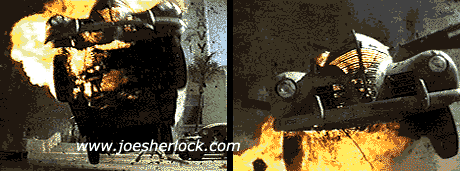
'Tora, Tora, Tora' was a much better flick.
Despite these shortcomings, I found the book informative and recommend it. We need to be reminded of the bravery of those who came before us. December 7, 1941 was, indeed, "a date which will live in infamy." Never forget. Never let down our guard. (posted 12/6/16, permalink)
'Paul McCartney: The Life' by Philip Norman
This 864-page doorstop of a book is a long and winding read. It is tediously detailed and, while informative, is often so boring that I had to slog through it. It's a shame because, as the driving force behind the Beatles and the most successful of the bunch in the lengthy post-Beatles era, Paul McCartney is an interesting subject. I expected Philip Norman to offer a real page-turner.
Unfortunately, the book offers little in the way of a critical look at McCartney-authored songs, which range from brilliant ('Yesterday') to trite and vapid (much of the Wings catalog). I also found several errors regarding Beatles/McCartney events in the U.S. and I'm certainly no Beatles expert.
The author doesn't think much of the 1960 Ricky Nelson song, 'Lonesome Town', covered by Paul during a Linda tribute concert. Norman describes the lyrics as "self-dramatizing teenage drivel, typical of the time." Yeah, right. As if McCartney's 1975 ditty, 'Spirits of Ancient Egypt' wasn't many times more banal: "You're my baby and I love you / You can take a pound of love and cook it in the stew."
Verdict: Not worth your time. (posted 11/30/16, permalink)
'Wake Up America: The Nine Virtues That Made Our Nation Great - And Why We Need Them More Than Ever' by Eric Bolling
Based on the title, I feared that this was going to be a hokey, cliche-ridden, rah-rah cheerleader chant for 'Murica. What I found instead was a thoughtful, eminently readable book which relayed a positive message - a call to Americans to rediscover and embrace the values that made our country exceptional. The facts in the book were well-sourced.
It is a reasoned rant against the trophies-for-everyone, safe-space, special snowflake, everything-is-racist, helicopter-parenting culture of today.
Verdict: Highly recommended. (posted 11/21/16, permalink)
'We Have The Technology: How Biohackers, Foodies, Physicians, and Scientists Are Transforming Human Perception, One Sense at a Time' by Kara Platoni
This is a quirky, 300 page book, discussing how technology will alter our perceptions of taste, sight, sound, pain and other senses. As well as reality itself. The chapters on grinders, people who implant magnets and other devices in their bodies was weird and reminded me of Medieval trepanning of the skull, which didn't work out so well for most.
The book meanders between facts, theories and anecdotes as it moves from well-equipped labs, to bars, perfumeries, tattoo parlors and biohacker/grinder basements. There was an odd mix of characters and that made the story uneven. Some subjects were quite fascinating held my interest, others not so much.
I've been told that you always learn something in every book. Well, I learned that there's a drink called the Belfast Car Bomb. Recipe: Pour Kahlua coffee liqueur into a shot glass. Top with Bailey's Irish Cream and Jameson whiskey. Drop the shot glass into a half-pint of Guinness, and consume immediately. Boom!
Verdict: Meh on the book but - the drink recipe - is a knockout! (posted 11/17/16, permalink)
'Prestige, Status and Works of Art: Selling The Luxury Car 1888-1942' by Thomas Solley
Let's begin by discussing what this book is not. It is neither a history of luxury automobiles (you can find that here) nor a book full of full-page color photos. Rather, it is an attempt - a successful one I believe - to capture the feel and look of period advertising for luxury and near-luxury cars of yore by selectively publishing images (most are small as well as black and white) of such machines. Most of the images selected by the author are evocative and stunning.
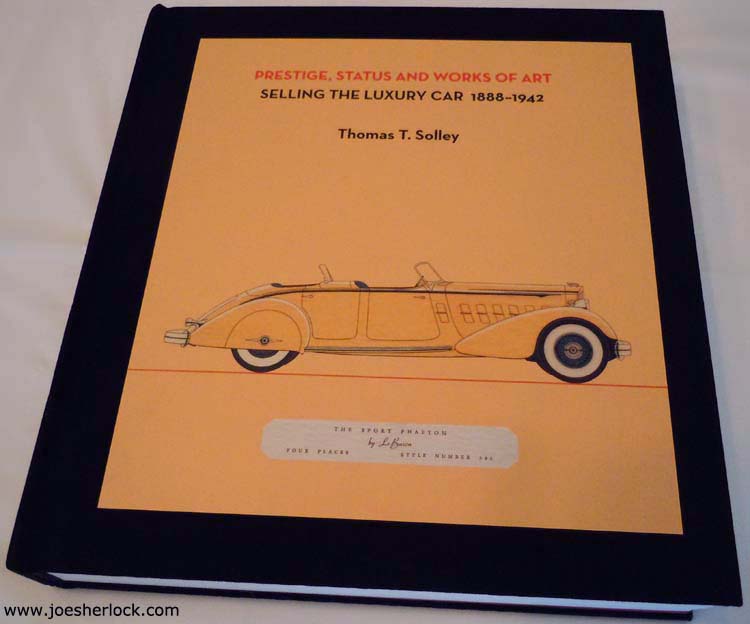
First published in 2008, this large-format, 430-page tome offers documentation of ads, photos and catalogs for luxury marques from the dawn of the automobile age to 1942. Catalogs from coachbuilders are also covered.
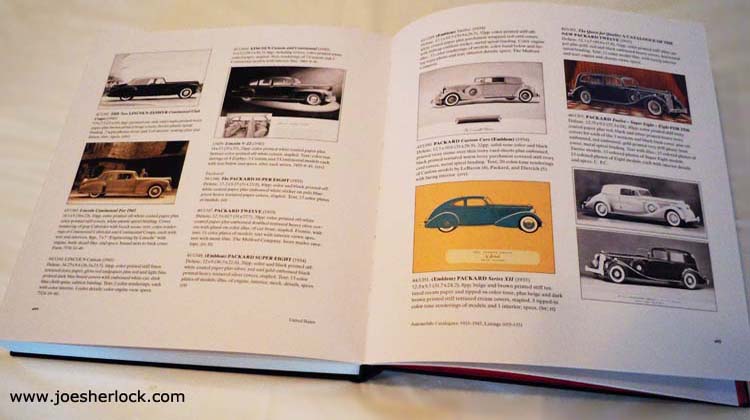
This is no mere picture book. The author provides much commentary and his expertise in automotive history is impressive. I increased my personal knowledge of automotive history by reading Mr. Solley's work. An example:
"In France, one development by the Carrossier J. Saoutchik is worth mentioning. For the 1938 season, a Packard and a Delage were built with unusual doors, which opened to the back, parallel with the sides of the car." ... shortly afterward, a British patent was taken out on this design by (coachbuilder) James Young Ltd. - part of the Barclay Group - and featured on several later 1938 Rolls Royce and Bentley James Young models.
After the war, this patent was reportedly sold to Volkswagen, undoubtedly quite a profitable affair for Barclay, for whom it had become of limited value, while crucial to VW for the parallel sliding door design of its many mini-van versions. This type of door is now a common feature on many van-type vehicles and presumably proliferated with the expiration of the controlling patent many years ago."
Verdict: Highly recommended. (posted 11/9/16, permalink)
'1941: Fighting the Shadow War - A Divided America in a World at War' by Marc Wortman
This work describes the build-up to World War II during the pivotal year, 1941, with special emphasis on the clandestine actions taken by FDR in support of Great Britain. President Roosevelt had to contend with continued isolationism as he attempted to sway public opinion in favor of helping our Allies. The author does a good summary of the rancorous relationship between the White House and Charles Lindbergh, a prominent figure who was the poster boy for the isolationsts.
Wortman's book provides a good overview and was, for me, an enjoyable read, although events have been described more fully elsewhere. For example, the Lindbergh-FDR feud was explored in depth in 'Those Angry Days: Roosevelt, Lindbergh, and America's Fight Over World War II, 1939-1941'.
The industrial built-up needed to win the war, is well covered in 'Freedom's Forge: How American Business Produced Victory in World War II'. An excellent book which covers 1941 from Japan's viewpoint is 'Japan 1941: Countdown to Infamy'. The most critical month is covered in great detail in 'December 1941: 31 Days that Changed America and Saved the World'.
Nevertheless, the story - as told by author Marc Wortman - flowed well and I recommend this book to anyone interested in World War II. (posted 11/3/16, permalink)
'My-Te-Fine Merchant: Fred Meyer's Retail Revolution' by Fred Leeson
Fred Meyer is now a chain of superstores in the Pacific Northwest. Specializing in groceries, it also sells liquor, clothing, footwear, bedding, furniture, jewelry, beauty products, electronics, toys, lumber, garden supplies, flowers and housewares. One of its early house brands was My-Te-Fine canned goods - hence the title of the book.
The company was founded as a single Portland grocery store in 1922 by Fred G. Meyer, a German immigrant. This book is his biography and is the result of thorough research by the author.
I have a couple of stories about Fred Meyer. When we first arrived in Oregon in mid-1978, the exterior color scheme of the Corvallis store (tilt-up concrete construction with lightly-textured beige paint applied to the surface and a reddish brown 'racing stripe' applied horizontally just below the roofline) looked very similar to a New Jersey chain of discount stores we had patronized often, including just a few weeks before we moved. That store's name was Two Guys; it was very well-known in the mid-Atlantic states and New England. My 11 year-old son, immediately renamed Fred Meyer as One Guy. A couple of months later, Fred Meyer died and my son changed the designation to Dead Guy. We adopted the nickname and it was quite disconcerting for our neighbors to hear, "I'll be back in a little bit; I've got to pick up something at Dead Guy."
Reading the book, it becomes quickly obvious that Fred Meyer was a driven and very successful entrepreneur who could be a real prick as well. He was estranged from his brothers and, despite being a centimillionaire, bequeathed a mere $14,000 to his remaining sister in his will. He drove employees to tears, often referred to his stepson - a company executive - as "the biggest dummy in the room." Many talented executives left the company because of his spiteful rants and his extreme cheapness. He has some odd beliefs, based on his Rosicrucian leanings. "If you had a cold and your nose was dripping and running, that was fantasy to (Fred Meyer). You just thought you did." Sympathy for employee ailments simply wasn't in Fred's wheelhouse.
Even after his death, the negative culture he created lived on. Fred Meyer, Inc. brow-beat suppliers and vendors with unreasonable demands. I heard this on more than one occasion from people I knew who did work for the company. And that brings me to my second story. In the early 1980s, my own display manufacturing company did business with Fred Meyer Inc. for a brief period. We soon refused to do further work for the retailer because of the way we were treated. We were a valued supplier to too many other large companies and didn't need the aggravation of dealing with the ungrateful and imperious jerks at Freddie's.
Prior to being acquired by supermarket Goliath Kroger, Freddie's demonstrated that someone at the firm had a sense of humor by naming the house brand of tissues and paper products 'Chateau'.
This book was quite detailed and seemed accurate in its description of the man and his business. If you're from the Pacific Northwest, you'll probably enjoy this behind-the-scenes history of a familiar retailer.
Verdict: Recommended. (posted 10/26/16, permalink)
'Over the Top and Back: The Autobiography' by Sir Tom Jones
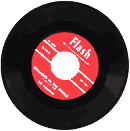 We celebrated our third wedding anniversary in 1969 with a dinner show at Latin Casino; the featured performer was Tom Jones. We celebrated our third wedding anniversary in 1969 with a dinner show at Latin Casino; the featured performer was Tom Jones.
His autobiography is as good as his performance was those many years ago. The book is full of anecdotes - many quite humorous - about his life and legendary career. He grew up as an impoverished lad in a small Welsh coal-mining town, contracted - and survived - tuberculosis, got his teen girlfriend pregnant, married her (they're still married), supported his family with various menial jobs (working in a glove factory, selling Electrolux vacuum cleaners door-to-door and living on the dole) while spending weekends performing with bands at various local dives.
The book gives a fascinating, first-person and honest look at the early stages of rock as well as the British Invasion. Jones rise to fame and all the bumps along the way are revealed in detail without being boring or self-centered. Tom comes across as a down-to-earth fellow with great stories - including some unbelievable Elvis, Sinatra, Dick Clark and Engelbert Humperdinck ones - that could just as easily and enjoyably be well-told over several drinks.
Good writing carefully blends facts, objects, places, people and events together using personal anecdotes as a catalyst to engage the reader and produce a fine brew of a tome. Tom Jones has done just that.
I highly recommend this eminently readable and thoroughly enjoyable book. (posted 10/20/16, permalink)
'Off Script: An Advance Man's Guide to White House Stagecraft, Campaign Spectacle, and Political Suicide' by Josh King
Perception is reality, meaning that you are whoever people think you are. That is the essence of politics. Author Josh King was an political advance man working for Michael Dukakis and, later, Bill Clinton; his job was to "frame the optics" at political events so that the candidate (or president) looked his/her best.
He provides examples of success and failure in the image-crafting biz. The problem is that he expends incredible amounts of ink discussing the minutiae of the Dukakis Tank Incident, where the diminutive presidential candidate took a ride in the massive Abrams M1A1 tank where he "looked like a peanut," in the words of one observer. Overlooked was the fact that this unfortunate scene was not the cause of Dukakis' downfall.
Far more damaging were the relentless Republican revolving door ads, calling attention to Governor Dukakis' pardon of Killer Willie Horton. And Governor D's stunned deer-in-the-headlights response to Bernard Shaw's cringe-worthy debate question about the hypothetical rape and murder of the governor's wife. Most would agree that Dukakis lost because he was a dull, just-the-facts guy against a more experienced, somewhat more charismatic George H.W. Bush who basked in Reagan's glow and was the beneficiary of a still-growing economy. The repetitive tank story kept cropping up throughout the book and made those parts tedious and boring.

King's discussion of the changes in the public's media choices over the last 25 years is far more insightful. In 1988, there was no internet and CNN was the only cable news network. FoxNews and MSNBC didn't arrive until the mid-1990s. These diminished the power of network television. All of television became further threatened by the rise of internet political news sources - Drudge, Politico, Lucianne and, more recently, Breitbart. It is now almost impossible to frame the optics of still and video images now that everyone has cell phone cameras which produce surprisingly high-quality images. These photos and videos, often embarrassing to candidates, can be posted almost instantly to YouTube, Facebook or other social media.
The result of this sea-change in media coverage is Obama's "Vanilla Presidency" - so named by Mr. King. Obama has been more guarded and more protective of the presidential persona than anyone in history. He has used mass releases of official, 'selected' White House photos while restricting traditional reporters' and photographers' access. It's his way of framing things. Obama has also appeared on various YouTube 'shows' and podcasts in an attempt to circumvent traditional media and communicate with his targeted base directly.
Candidate Trump has taken things a step further, co-opting the news cycle by using Tweets (not always to his advantage) to 'make' news. He also gets gobs of free television time because he always has something newsworthy/outrageous/crazy to say and readily agrees to telephone interviews with television opinion makers. This has given Trump great national name recognition and permitted him to capture the Republican presidential nomination with minimum dollars spent on ad buys. The images of him flying to various campaign stops in Trump Force One and keeping his private jet visible in the background as he gives speeches in large airport hangers have also been imprinted in public's mind. Will this strategy allow Trump to capture the presidency? Josh King doesn't know and neither do I. We'll soon find out though.
Verdict: Decent read, if you skip the tank parts. (posted 10/12/16, permalink)
'Eruption: The Untold Story of Mount St. Helens' by Steve Olsen
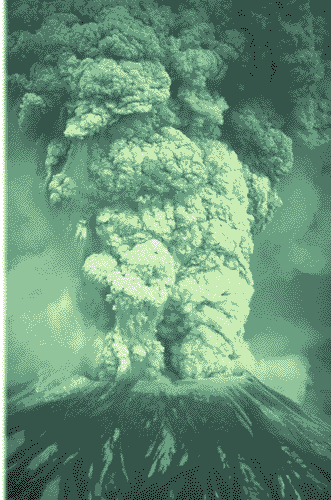 Having experienced the Mt. St. Helens eruption firsthand, I looked forward to this comprehensive account by author Steve Olsen. I wasn't disappointed. Having experienced the Mt. St. Helens eruption firsthand, I looked forward to this comprehensive account by author Steve Olsen. I wasn't disappointed.
The author weaves history of the Forest Service, the Northern Pacific Railroad and timber giant Weyerhaeuser and Mount St. Helens itself, along with the science, politics and social history.
I enjoyed reading the history of Weyerhaeuser and Hill's Railroad endeavors, both of which were central to the development of the Pacific Northwest and the development of the area's logging industry, in which Weyerhaeuser dominated.
The eruption began just as I was getting ready to leave my Corvallis, Oregon home for a sales trip which included towns along the Columbia River. I had an incredible view of the ever-growing, fast-moving ash plume, since I was staying at a motel overlooking the Columbia Gorge in Hood River, Oregon. I was provided a ringside seat - a north-facing room with a large picture window.
The book has a few shortcomings, though.
• There was no discussion of the fact that Mt. St. Helens' quakes and vapor plumes were generally treated as a joke by many Northwest residents until the mountain violently erupted on May 18th.
• In the beginning of the book, Olsen writes of the state of the culture, mentioning disco. Well, even in the Pacific Northwest, which is typically very late to the party for most fads, disco was dead. My plastic firm fabricated mirrored Plexiglas panels for a newly-opened disco inside the T&R Restaurant & Bar, located in a truck stop in Albany, Oregon in early 1979. It was the last disco-related job we ever did, not surprising considering that by the time discotheques reached the truck stop level, the fad was obviously over.
• I wish the book had included more about the effects of the ash which were widespread and the problems of ash removal. Many car and truck engines were ruined by the highly abrasive ash. Lots of air cleaner filters were sold, too. The Washington State police and many local sheriffs had their cars retrofitted with large externally-mounted air cleaners to deal with the ash problem.
• The author wrote of aftershocks and mini-eruptions after May 18th but I couldn't find any reference to the mid-October 1980 event which sent plumes ten miles into the air and dropped ash south and west. I was on a business trip and stayed overnight at the newly-built, nearly empty oceanfront Hilton in Newport, Oregon. When I awoke the next morning, the beach was covered in gray ash, as was my nearly-new Oldsmobile which was covered by at least an inch of wet ash. I thoroughly washed the car, cut short my trip and drove home, stopping along the way to get a new filter for the car's air cleaner. I installed it in my driveway after carefully wiping off the inside of the metal air cleaner.
These minor quibbles aside, this was a fascinating and informative book. Recommended. (posted 10/6/16, permalink)
'Door To Door: The Magnificent, Maddening, Mysterious World of Transportation' by Edward Humes
In parts of the book, chapters contain a synopsis on the transportation issues involved in making a variety of common products, such as coffee, aluminum soda pop cans, Domino's Pizza, UPS, LA port operations and the like. Each is an informative read.
Unfortunately, too many chapters are blatantly biased against private automobiles. The author loves bicyclists, walkers and the like and hates anything with wheels and tires. Especially if it has a V8 motor. As expected, he is obsessed with pollution, global warming and loves mass transit. As for bicycles, he lauds Portland, Oregon where cyclists roam free, neglecting to mention Bicycle Terrorists, those arrogant jerks who repeatedly trample the rights of others, including pedestrians.
Someone - I think it was George Carlin - wished that publishers of steamy novels would print the dirty pages on blue paper, so that readers didn't have to "read the whole damn book to get to the good parts." I wish Mr. Humes had arranged to print his socialistic, liberal, anti-pollution rants on green paper, so we could skip them.
Verdict: OK, with some bright spots, if you ignore the greenie, lefty rants. Don't buy it; get it from the library as I did. You'll save energy, while depriving Mr. Humes of excessive royalties. (posted 9/28/16, permalink)
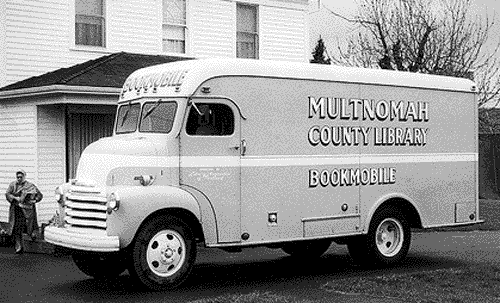
'The Third Wave: An Entrepreneur's Vision of the Future' by Steve Case
Before reading this book, I saw the author interviewed on BookTV by Rep. John Delaney (D-Maryland). It was informative and interesting with good questions by the congressman - who used to own a business - and engaging answers by Case, cofounder of AOL.
The book defines the first wave as the birth of the internet and its first baby-steps on the World Wide Web. The second wave happened when companies, such as Google and Facebook, built on the 'nets foundation to create sophisticated search and social networking capabilities. The third wave, writes Case, will be when "entrepreneurs will vastly transform major 'real world' sectors like health, education, transportation, energy, and food - and in the process change the way we live our daily lives." Also, the Internet of Things, which means that your refrigerator will harangue you about its needs and be subject to hacking. I don't know about you but I want a non-hackable appliance that does its job and shuts the hell up.
I enjoyed the book at the start but many of Case's assumptions did not ring true for me. His proposal that fast-growing 'gazelle' businesses devote some of their time and money to charitable causes is all wrong. Venture capitalists want return on their investment, not good works. And, any gazelle that takes its eye off the main objective will soon be eaten by some competitive industry predator.
The very idea of entrepreneurs totally revising highly regulated and unionized structures on a national scale (the educational system) is a waste of an innovators' time and talent. The payback timeline is too long and the risk/reward just doesn't pencil out. Fixing health care - a highly-regulated casino, designed to make sure that the house (insurance companies) always wins - will not be accomplished by some clever individual working in a rented cubicle in Cupertino.
Case's book is full of regurgitated ideas and is, in reality, a shallow, pencil-sketched autobiography - one that is often boring. He also sings the praises of Franklin Raines and Jamie Gorelick, two people I think should be in jail.
Verdict: No real vision offered here; therefore, this book is Not As Advertised. You'd be better off spending your money on a Tarot card reader. (posted 9/22/16, permalink)
'Crisis of Character' by Gary J. Byrne
Last month, the author has been making the rounds of various political shows talking up his book on the Clintons, especially Hillary. Who can blame him? This book will hit the remainder bins hours after the November presidential election.
Gary J. Byrne worked in the Clinton White House as Secret Service officer - Uniformed Division. He saw lots of stuff, of course, but not so much first-hand. Most of the book is an autobiography, detailing the author's experiences as an air marshal and as a training officer in the Secret Service. There's a lot of griping about the tough conditions in the service, which has been written about by other agents in other 'tell-all' books.
If you are expecting to find lots of new scandalous Clinton stuff - there's plenty already - you won't find it in Byrne's book. Everybody already knows that Hillary is vindictive and has a bad temper and that Bill fools around. And that they're both morally bankrupt.
Verdict: Nothing to see here. Move along. (posted 9/14/16, permalink)
'18 Holes With Bing: Golf, Life, and Lessons from Dad' by Nathaniel Crosby
There are numerous books about Bing Crosby, including the unflattering tome by his sourpuss son, Gary, titled 'Going My Own Way'. It portrayed Bing as cruel, cold, remote, and both physically and psychologically abusive.
In 1980 or thereabout, I was reading another hatchet job, 'Bing Crosby: The Hollow Man'. My mom was visiting and, seeing the paperback, remarked, "I'm glad your dad didn't live to see you reading that trash." She then told me the story that, when my dad was in California training for action in he Pacific Theater during World War II, he was in a bar with his Navy buddies when Bing Crosby walked in and picked up the bar tabs for everyone in uniform. Nice guy.
There are lots of stories about Der Bingle's many acts of kindness to individuals. During his lifetime he raised tens of millions for charity. On the other hand, he was estranged from the four sons from his first marriage; two of them committed suicide.
Bing was a complicated, imperfect man. He was a legendary singer - the best-selling recording artist of the 20th century, having sold over one billion records, tapes, compact discs and digital downloads around the world. He was an Academy Award-winning movie star, too. But he loved golf and that's what this book is mostly about.
 This is not an objective book, it is more of a billet doux from a son who lost his dad when he 15 years old. Nathaniel, Bing's youngest son from his second marriage, was a high-level golfer who won the U.S. Amateur at age 19 in 1981, at the time the youngest-ever winner of that event. This is not an objective book, it is more of a billet doux from a son who lost his dad when he 15 years old. Nathaniel, Bing's youngest son from his second marriage, was a high-level golfer who won the U.S. Amateur at age 19 in 1981, at the time the youngest-ever winner of that event.
The book had numerous humorous anecdotes involving Bing and his buddies. In one Bing and his friend, comedian, drinking buddy and bandleader Phil Harris were traveling through Scotland. "At midnight they passed a large distillery that clearly was a twenty-four-hour operation." "Look, Phil, they're making it faster than you can drink it," quipped Bing. Yeah," Harris replied, "but I've got them working nights."
Nathaniel Crosby admitted that, in 1989, his annual salary was only "around $40,000." I was shocked that a famous golfer, who was head salesman and promo guy for a large golf equipment company and carried the Crosby heritage, was compensated so poorly. By comparison, the top salesman (who was about the same age as Nathaniel) at my relatively-small and obscure plastics manufacturing firm was paid about $54,000 that same year.
Why didn't any of Bing's many wealthy friends offer his son a good-paying job? Was there something wrong with Nathaniel?
As the book morphed from Bing stories to stories about Nathaniel with Bing's old friends, it became less interesting and more name-droppy.
Verdict: Too much Nathaniel; not enough Bing. Skip it. (posted 9/8/16, permalink)
'Game Of Crowns: Elizabeth, Camilla, Kate, and the Throne' by Christopher Andersen
I remember visiting my friend and grade-school classmate, Sammy Clayton, after school on June 2, 1953. We were playing outside when his mom insisted we come inside and watch something on television. She said, "You won't understand now but this is history being made. A British Coronation is something rare. You may never see another one in your lifetime." And, to date, I haven't.
It was a big deal getting the event televised in a timely manner. In those pre-videotape, pre-satellite days, the ceremony was filmed and the undeveloped rolls were rushed to Heathrow airport, loaded into a modified P-51 Mustang and flown to the U.S. (with a quick refueling in Labrador) and was developed enroute in a makeshift, cramped darkroom. That was the black and white film shown to American television audiences.
Andersen's book is a gossipy guilty pleasure and a quick read, focusing on the machinations, tactics and strategies of the various members of the royal family as they jockeyed for position against other members of the royal household.
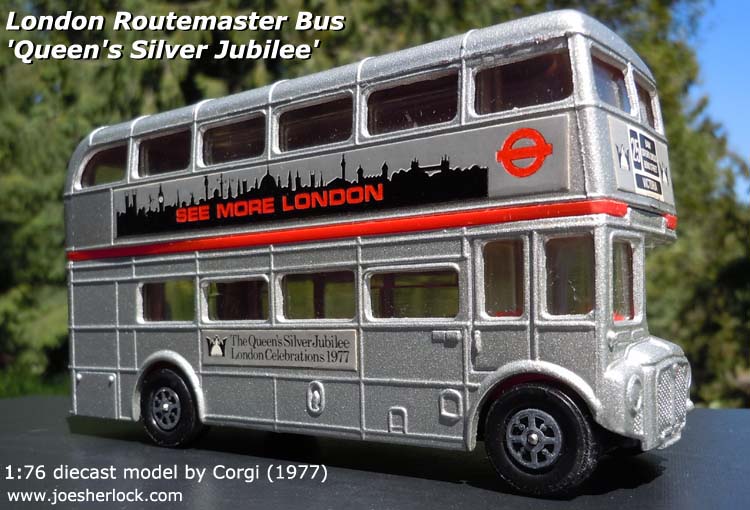
I've read a lot of the fumbles and foibles of the Brit royalty before, so I wasn't overwhelmed with new information but enjoyed the book anyway. And there were tidbits such as this: On August 27, 1997 psychic named Edward Williams walked into the South Wales police station and "told police that he had a premonition that Princess Diana was going to die. He had previously predicted - correctly - that Ronald Reagan and Pope John would be victims of assassination attempts." Diana was killed in the Paris car crash on August 31, 1997.
Verdict: Recommended. Like a proper summer dessert, it's fast and not too filling. (posted 8/30/16, permalink)
'Shoe Dog: A Memoir by the Creator of Nike' by Phil Knight
This autobiography is the story of the man, the company he built, the friends he made, of massive business struggles, the many business relationships he encountered and the great adventures - both personal and business.
Phil Knight, Nike founder and board chairman, began with a fifty dollar loan from his dad (after Phil sold his beloved MGA sports car and traveled the world) and an idea to import high-quality running shoes from Japan. Less than 50 years after this inauspicious start, Nike has grown to a $30+ billion dollar colossus.
I found Knight to be a believable and sympathetic character and I identified with his many business struggles as a fellow Oregon business owner. Prior to going public, his fast-growing company suffered continual cash flow crises. To those who haven't owned a business, his many struggles may be difficult to understand. People ask, "How can you be profitable and still be broke?"
 Allow me to elaborate on cash flow, something Phil's book fails to do, although he mentions the subject many times in the book: Allow me to elaborate on cash flow, something Phil's book fails to do, although he mentions the subject many times in the book:
In the early days of the software business, companies packaged 80¢ worth of floppy disks plus a $10 manual and sold it for $400. In such a scenario, it was easy to self-fund expansion with the $389.20 which remained. That's how Adobe, Microsoft, Electronic Arts and Intuit could grow so quickly in the 1980s. Alas, most businesses aren't so lucky. Even a good manufacturer will spend 65¢ in direct costs for every dollar he sells.
Most well-run manufacturing, distribution, or importing businesses with $1,200,000 in annual sales ($100,000/month) will have about 50 days of inventory ($110,000) and 45 days of accounts receivable ($150,000). If the business doubles in a year - as Phil's did often and mine did once - the business will have doubled its accounts receivable and inventory, requiring an additional $260,000 ($110,000 plus $150,000) investment.
A really well-run business might have an after tax profit of 7% or $70,000 on a million in sales - unlike those software giants of the '80s. So, where how does one make up the difference between the $260,000 needed to grow and the $70,000 available? By borrowing, usually from a bank. And the loan required will, in reality, be much more than $190,000 ($260,000-$70,000) because my example is very oversimplified and doesn't include things like work-in-process, raw material inventory, letters of credit, loan payments and other items which inflate along with sales. And the fact that most companies don't grow linearly; instead sales grow in erratic up-n-down seasonal spurts which further exacerbates cash flow troubles.
And, if you have more sales growth the following year, you'll have to borrow even more money.
Unfortunately, most banks take a dim view of young, closely-held, fast-growing businesses. A particular problem with the very insular Oregon banks in the 1970s through at least the 1990s, was that they were very suspicious of receivables from out-of-state companies that weren't household names. If you sold to Tektronix, OHSU, Intel, Oregon Steel Mills or Fred Meyer, you were OK in a Portland banker's mind because he/she drove past their facilities on a regular basis and read about them in The Oregonian.
Knight's company (and mine) sold products to good customers in places like Massachusetts, New Jersey and Illinois but these firms were unknown to local bankers. Therefore, they were reluctant to lend much against receivables. If an auto sales lot goes belly-up, bankers can quickly seize assets and they know guys who can auction off the car inventory. But they don't have contacts to get rid of shoe inventory (or plastics display inventory), so they take a dim view of lending much against inventory of stuff they can't readily sell-off in a crisis.
Blue Ribbon Sports (Nike's original name) was bedeviled with banking problems because the company was always growing fast and continually needed more money. In 1971, First National Bank of Oregon - an old-line firm founded in 1919 - told Phil to take a hike; they didn't want him as a customer any more, even though Blue Ribbon Sports was making all loan payments on time. The growing company made the bankers uncomfortable; the bank's officers understood computer chips, timber and steel fabrication, but the idea of selling imported shoes (sports sneakers, for Pete's sake) to unfamiliar stores outside the Northwest was just too weird for their minds to encompass. (First National later became First Interstate and is now part of the Wells Fargo empire.)
Later, Phil's shoe company went with the Bank of California (now Union Bank of California). Then a shoe customer, United Sporting Goods, paid for a $50,000 order with a check that bounced. The Bank of California not only canceled Blue Ribbon's line of credit but froze Phil's accounts and - amazingly - turned him over to the FBI for fraud investigation. This $50,000 bad check from one customer represented less than 0.5% of the shoe firm's annual sales at the time. The bank's actions constituted a monumentally stupid overreaction, especially since prior to the customer's rubber check, Blue Ribbon was prompt with all loan payments.
By comparison, in 1983, I had a customer bounce a big check which represented 1.5% of my annual sales - three times as big relative to Phil Knight's problem. My bank saved my bacon by making a quick bridge loan until the customer finally made good on the check a few nerve-wracking weeks later.
The Bank of California quickly got its comeuppance when they lost the business of a Nissho, a large trading company, because of how badly they treated Phil, who was also a customer of Nissho.
This is an outstanding book which tells a great story (many great stories, actually). You'll enjoy it whether you're in business, a fitness enthusiast or just a reader interested in a compelling tale.
Verdict: Highly recommended. (posted 8/24/16, permalink)
'The Man Who Saved The V-8' by Chase Morsey, Jr.
Every big business is full of unsung heroes who make things happen or help do so. They are not known to the world at large. In the acrylic plastic business, J. Franklin Moore and Bob Gardner come to mind.
These folks are the MVPs of modern American industry. We owe them much.
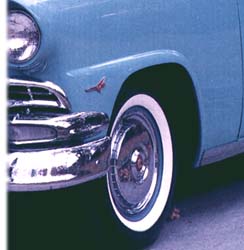 The author, Chase Morsey Jr., fits in this category. When he joined Ford Motor Co. in 1948, he had no idea of the significant contributions he would make to the auto industry. Following World War II, FoMoCo was in turmoil. The company had suffered under the increasing lunacy and unpredictability of founder Henry Ford, whose emerging dementia had him on the trolley line to Crazyville. He had tried to run FoMoCo into the ground with his agrarian-focused, semi-addled brain and his refusal to add modern improvements to his cars. The author, Chase Morsey Jr., fits in this category. When he joined Ford Motor Co. in 1948, he had no idea of the significant contributions he would make to the auto industry. Following World War II, FoMoCo was in turmoil. The company had suffered under the increasing lunacy and unpredictability of founder Henry Ford, whose emerging dementia had him on the trolley line to Crazyville. He had tried to run FoMoCo into the ground with his agrarian-focused, semi-addled brain and his refusal to add modern improvements to his cars.
His grandson, Henry II took the reins and hired the best and the brightest, nicknamed the Whiz Kids, to help bring modern management methods to the automaker. One of the original Whiz Kids quickly hired Morsey to help.
I never knew this before but the Whiz Kids, in a misguided example of value engineering (and there of millions of examples of those across the spectrum of American manufacturing), were planning to replace Ford's iconic V8 engine with a straight six because it 'worked' for Chevrolet. Morsey, a V8 Ford enthusiast from way beck - his first car was a mid-1930s Ford flathead V8, undertook fast and furious campaign to save the V8, backing his recommendations with solid facts and research.
He was successful - a modern overhead-valve V8 was developed and variations of it were used in Fords, Mercuries, Lincolns and Continentals for many years. And, of course, Thunderbirds:

This book is a straightforward presentation of the author's career at Ford from the late '40s to the mid-60s. There are many great stories between its covers. It gives the reader a feel for how the auto business developed after WW-II and the use of modern marketing analysis, targeted advertising and consumer research to develop salable product.
Chase Morsey Jr. died in February, 2016 at age 96 after a full and interesting life.
Verdict: A must read for all car guys. (posted 8/18/16, permalink)
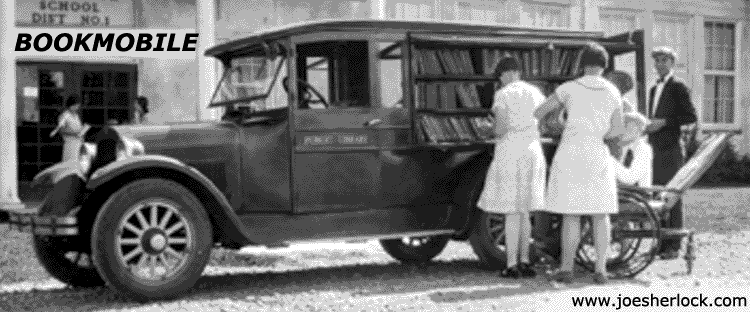
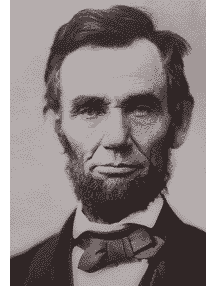 'Andy Warhol Was A Hoarder: Inside the Minds of History's Great Personalities' by Claudia Kalb 'Andy Warhol Was A Hoarder: Inside the Minds of History's Great Personalities' by Claudia Kalb
This book is a collection of fascinating stories of historic figures with an analysis of their personalities, maladies and mental disorders through the lens of modern psychiatric theory psychology.
Albert Einstein, Marilyn Monroe, Abe Lincoln, Charles Darwin, Frank Lloyd Wright and others are subjects of the author's scrutiny.
The stories are a blend of interesting biographical information followed an analysis of the conditions/disorders with speculation about how the disorder affected the person's accomplishments.
For me, there wasn't enough bio and too much psycho.
I enjoyed reading the book; it offered an engaging peek into the minds and disorders of several notable personalities. Of course, all the subjects are dead and aren't around to defend themselves, so the pop-psychology came off as a bit facile.
If only diagnoses were this easy.
Verdict: Recommended. (posted 8/10/16, permalink)
'Ninety Percent Of Everything: Inside Shipping, the Invisible Industry That Puts Clothes on Your Back, Gas in Your Car, and Food on Your Plate' by Rose George
Logistics, a military term co-opted by industrialists in the 1960s, defines the complex movement of manufactured products from factory loading docks to the ultimate customer. Logistics include both the physical movement of the product (truck, rail, air, ship, etc.) as well as the ownership transfers (e.g. - factory>importer>master distributor>wholesaler>retailer>consumer).
George's book attempts to cover the movement of goods by sea, specifically the use of container ships, a fairly recent development using those now-ubiquitous large cargo intermodal stacking containers seen on highways, railroads and major seaports.
The book provided much new and interesting information at the beginning. For example, long-distance shipping "is so cheap that it makes more financial sense for Scottish cod to be sent ten thousand miles to China to be filleted, then sent back to Scottish shops and restaurants, than to pay scottish filleters. A Scottish newspaper called this 'madness' but actually it's just shipping."
Ms. George traveled halfway across the world on a container ship owned by Maersk, described as "the Coca-Cola of freight with none of the fame." It is Denmark's largest company - much bigger than Lego. Maersk's sales are "equal to 20% of Denmark's GDP; its ships use more oil the entire nation."
This book started out great but quickly lost its way, padded out with a series of anecdotes about whales, pollution, climate change and piracy. That's too bad because the book was full of fascinating facts interspersed in this meandering, stream-of-consciousness travelogue. For example the Strait of Malacca, a narrow (1.7 mile wide) stretch of water between the Malay Peninsula (Peninsular Malaysia) and the Indonesian island of Sumatra, has annual traffic of 60,000 ships. On a radar screen, Ms. George observed "more than 200 ships in a two-mile radius."
Verdict: often thought-provoking but, sadly, rudderless. (posted 8/4/16, permalink)
'The Road To Little Dribbling: Adventures of an American in Britain' by Bill Bryson
I have previously read, enjoyed and reviewed two of Bill Bryson's other books, 'At Home' and 'One Summer: America 1927'. I was a little disappointed with his latest tome.
In his previous books, I had no sense of his politics. This time, Bill advances several liberal screeds including wishing that Dick Cheney was dead. He also burdens readers with his grumpy old man act too frequently, lamenting the decline of nearly everything. He bemoans the sight of failing little towns with many boarded-up storefronts but, when he encounters a successful burg, he complains about the tourists (especially foreign ones) and the traffic. He also whines about TripAdvisor - a website which I've found to be quite useful. Of all the obscure villages Bryson visited in this book, I'm surprised he didn't visit Slightly Cross, which perfectly reflects his demeanor these days.
Nevertheless, I found some of his observational humor still intact:
• "The bus service ... is advertised as the Coastliner 700, which makes it sound sleek and stylish, possibly turbocharged. I imagined myself high above the ground in air-conditioned comfort in a plush velveteen seat, enjoying views over bright sea and rolling countryside through softly tinted glass, the kind so subtly colored that you feel like turning to the person beside you and saying, "Is this glass lightly tinted or is Littlehampton ever so slightly blue?" In fact, the bus when it wheezed in had none of those features. It was a cramped and airless single-decker filled with hard metal edges and plastic seats. It was the sort of vehicle you would expect to be put on if you were being transported between prisons."
• At the Swan Inn, near Lyndhurst, the barman wouldn't accept Bill's food order because "we're short of staff because it's a Sunday." Acknowledging that Sunday is one of their busiest days, the barman, noted that it's the staff's day off "because it's Sunday, you see." Bryson refers to this exchange as an example of the "hopeless, inept fuckwits that God has strewn along the Bill Bryson Highway of Life."
• Whelks are a type of sea snail, or gastropod. Bryson relates that, long ago, his future wife "took me to a seafood wagon and bought me a little tub of whelks. If you have never dined on this marine delicacy, you may get the same experience by finding an old golf ball, removing the cover and eating what remains."
• Saint Swithun "was Bishop of Winchester in about 850. One day he came across a woman who was distraught because the eggs in her basket had broken. With a pious wave, Swithun made them whole again. ... Swithun became a cult. Cathedrals across England competed to get a piece of him. His head ended up in Canterbury, and other parts of him were distributed hither and yon. It is a little ironic that the man who could put eggs back together couldn't keep himself in one piece."
• The town of Salcombe "is smart and prosperous and lively. Everyone was dressed like a Kennedy at Hyannisport. I had to get a sweater out and tie it around my neck to keep people from staring."
• Byson doesn't think much of Douglas Brinkley, "a minor academic and sometime book reviewer whose powers of observation and generosity of spirit would fit comfortably into a proton and still have room for an echo."
• "Bus shelters in Britain used to be like little cottages, with pitched roofs and built-in wooden benches. Now they are just wind tunnels with advertisements."
• After dining at an nearly-empty Indian restaurant, Bryson suggested that it could be made "into an Elvis-themed restaurant. You could call it 'Love Me Tandoor'."
• "At Garsdale Head, a lonely pass miles from anywhere, I passed the famous Moorcock Inn (or Nymphomaniac's Plea, as I always think it)."
• I was saddened to learn that Torquay, once a pleasant, upscale town on the southwest coast has become quite seedy and run-down. We visited it in 1995 and enjoyed it greatly, when it was known as the English Riviera - not to be confused with the Buick Riviera.
Verdict: While not as good as his other books, 'The Road To Little Dribbling' is still worth your time. (posted 7/27/16, permalink)
'Playing To The Edge: American Intelligence in the Age of Terror' by Michael V. Hayden
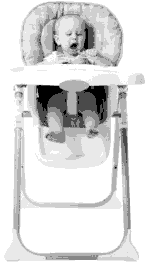 "What are you reading?" asked my wife. I told her the title. "Who wrote it?" I told her. "Who's that?" I replied, "The Gerber Baby guy we see on Fox News." "What are you reading?" asked my wife. I told her the title. "Who wrote it?" I told her. "Who's that?" I replied, "The Gerber Baby guy we see on Fox News."
Michael V. Hayden is a retired United States Air Force four-star general, former Director of the National Security Agency, one-time Principal Deputy Director of National Intelligence and the former Director of the CIA but, when we see him on television, he looks like what the Gerber Baby would look like after he reached his early 70s.
Hayden has great credentials and always sounds logical and intelligent when on television but his book was a disappointment. It was sometimes hard to follow because of all the Beltway acronyms. And too detailed at times. With a Joe Friday-esque 'Just the facts, Ma'am' writing style, the book lacked analysis.
I wish he had added a final 'Recommendations' chapter with suggestions on how to fix/improve things, especially since he was a witness to and part of much important military and political history over the past three decades.
Sadly, parts of Hayden's book were mind-numbingly boring. nvqrxdesadtrekldsuaiosrtbjgh ............
Ow! Damn, I just fell asleep and my head hit the keyboard.
Verdict: Skip it, Baby. (posted 7/21/16, permalink)
'Rise Of The Rocket Girls: The Women Who Propelled Us, from Missiles to the Moon to Mars' by Nathalia Holt
In the early post-war era of the late 1940s, California's Jet Propulsion Laboratory needed sharp mathematicians to calculate things like velocities and develop plotted trajectories for its new rocket program. They hired young women, who with only math smarts, pencils, paper, slide rules and French curves, transformed modern rocket design, helped give birth to the first American satellites of the late 1950s and, eventually, made space exploration possible.
Holt's book reveals the fascinating untold story of these women, given the job title of 'computer' because they mathematically computed stuff. We tend to forget those pre-computing machine days, when nearly everything was done by hand. The first computers were temperamental vacuum-tube nightmares, capable of only the simplest calculations.
I remember writing programs in FORTRAN and COBOL in the early 1960s and how excruciatingly frustrating it was to get them to run correctly. My early engineering days were filled with the generation of reports containing data presented in hand-drawn form done on onion-skin graph paper, so I can sympathize with the women's frustrations when they had to generate reams of curves and plots by hand and, if one data point changed, the entire graph had to be redone.
An interesting tidbit in the book was about Werner von Braun's contribution to the space shuttle program. The design of the various nearly-identical shuttles - Challenger, Discovers, Columbia, etc. - "was rooted in von Braun's Nazi Amerika Bomber project, a winged rocket that would ascend to suborbital space before dropping bombs on New York City." Even during World War II, the Big Apple was a terrorist target.
Despite advances in machine technology, the women continued to play an important part in everything from the first successful U.S. satellite to all various space probes to the moon, Venus and Mars. They also played key roles in the Voyagers as well as the Hubble project.
This entertaining book is a well-told story and a tribute to those unsung females and their myriad and significant contributions to space technology.
Verdict: Highly Recommended. (posted 7/13/16, permalink)
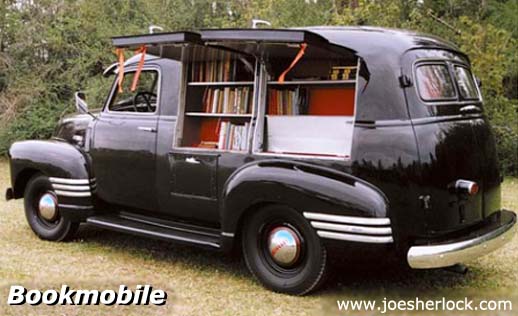
'The Last Goodnight: A World War II Story of Espionage, Adventure, and Betrayal' by Howard Blum
I think a deckled announcement or invitation is a perfectly acceptable thing, if a bit pretentious. On the other hand, a book with 528 deckle-edged pages just makes it more difficult to turn those pages and makes the book look ragged. It's contrived but so is the spy story, 'The Last Goodnight'.
The book is the biography of Betty Pack, an American who spied on behalf of the British before and during World War II. She spent much of her time seducing diplomats and military attachés across the globe in exchange for ciphers and secrets.
Most stories about spies - be they nonfiction or otherwise - present main characters who rise above themselves and commit heroic patriotic acts. Not so with Betty Pack does not come across as a heroine. In fact, she's not a very likable person - a serial adulteress, a woman who essentially ignores her two children and someone who doesn't hesitate to get an abortion when an unexpected pregnancy interferes with espionage. Peck spied because she loved the intrigue and the social interaction with important people. She wasn't even paid well for the work she did. Although she was often impoverished, she didn't seem to care. The thrill and selfishness trumped all else, it seemed.
Verdict: Don't waste your time. (posted 7/7/16, permalink)
'And Then All Hell Broke Loose: Two Decades in the Middle East' by Richard Engel
Are you confused about the Middle East? Me too. Between bizarrely different religious beliefs and a plethora of interpretations of them, incomprehensible tribal disputes, multi-millennial grudges, geographical boundaries arbitrarily set by powerful outsiders and multiple moral ambiguities (to our Christian eyes and ears), no wonder this sorry piece of the planet is hard to understand.
Regardless of whether you read the rest of the book, you should at least read the Prologue, in which NBC's chief foreign correspondent Richard Engel attempts to provide the historical context for the many Middle East disputes of today. I found it most enlightening.
For well over a half-century, primitive and poor countries have been ruled by tyrants or, as Engel calls them, Big Men: The Shah of Iran, Hosni Mubarak, Mu'ammar Gadhafi, the Assads, etc. As these Big Men became weak, sick, dead or overthrown, they were often replaced by chaos. A flawed, propped-up strong man government gave way to no government. Civil wars ensued.
America's efforts to "help" have only exacerbated things. Engel blames both George W. Bush and Barack Obama for the much of the disaster that is most of the Middle East today and he makes a good case for his positions.
For some 20 years, Engel has covered the Middle East. He has been under fire, blown out of his hotel bed and taken hostage. The author gives readers a street-level viewpoint, something seemingly never done by Middle East "experts." Engel comes across as far more believable than most television pundits, think-tank eggheads and State Department lackeys, to whom we are exposed in the media.
Verdict: An informative and eminently readable book. Highly recommended. (posted 6/29/16, permalink)
'Blood, Sweat And My Rock 'n' Roll Years: Is Steve Katz a Rock Star?' by Steve Katz
Katz was a founding member of the legendary Blues Project and Blood, Sweat & Tears. I saw BS&T at the Latin Casino once; they put on a pretty good show, although my musical interests are generally pre-Beatles era.
The book was a quick read and offered a first-hand perspective on band life in the late '60s and early '70s. Other than that, it wasn't very interesting to me.
Verdict: Recommended only if you're a diehard BS&T fan. (posted 6/23/16, permalink)

'The Industries Of The Future' by Alec Ross
Predicting the future is fraught with peril. History has proven many experts to be very wrong.
There is a tendency among all of us to be pessimists. We worry about the future because it is an unknown. We are concerned for our children's and grandchildren's future. We have seen entropy first hand and know that downward trajectories are natural phenomena. People get old, frail and sickly. Wood rots. Plastic embrittles, crazes and discolors. Steel rusts. Buildings and bridges crumble. The Roman Empire fell. We eventually return to dust.
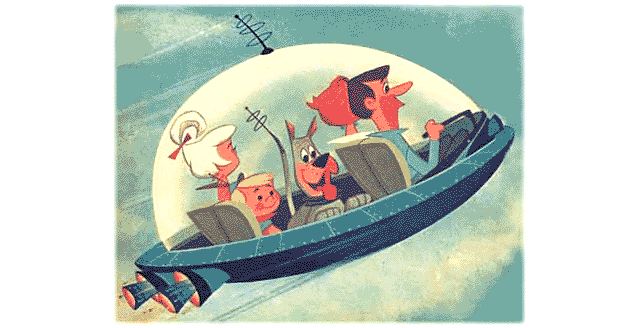
Those of us of a certain age were once told of a wonderful future that never came about - a nation of monorails and flying cars, smoking Lucky Strikes outside a cafe on Mars, elevators to the moon, a pill which fixed all ailments and underwater cities enclosed in giant Plexiglas domes.
Nevertheless, the 21st Century has turned out to be pretty good in general - so far.
Alec Ross gazes into his own crystal ball and attempts to forecast what's next for the world. Like many would-be futurists, he sees profound changes ushered in by advances in technology - especially robotics, big data, and genomics. He also discusses the implications of such changes for employment, wealth distribution and global trade.
He warns of possible calamities from cyberhacking. He asks whether the use of Paypal by Hamas be a good or bad thing. He predicts the rise of Uber for local courier service and food delivery.
Unfortunately, the book turns out to be a mostly superficial read sprinkled with some interesting anecdotes. There is little original research - just glib writing, tainted, I think, by the author's previous job as Senior Advisor for Innovation to the Secretary of State. As a result, praise for Hillary Clinton and her "accomplishments" is sprinkled throughout the book - revealing Ross' own bias about what he experienced in the 41 or so countries he visited while working for Queen Hillary.
As alternatives to this relatively shallow 'prediction' book, I would suggest 'Makers: The New Industrial Revolution' by Chris Anderson or 'Abundance - the Future is Better Than You Think' by Peter Diamandis and Steven Kotler. (posted 6/15/16, permalink)
'Those Angry Days: Roosevelt, Lindbergh, and America's Fight Over World War II, 1939-1941' by Lynne Olson
This is a comprehensive account of the contentious debate over American intervention in World War II. On opposite sides were two famous personalities, President Franklin D. Roosevelt, a sometimes half-hearted interventionist, and heroic aviator Charles Lindbergh, a committed isolationist who believed that German air superiority would conquer Europe and, possibly, America.
Spanning the years 1939 to 1941, the book vividly portrays the rancorous debate within the U.S. in the days before Pearl Harbor.
This is a book which is easy to read, as the narrative flows generally well, although the story bogged down with details from time to time.. The story of Britain's Ambassador to the U.S., Lord Lothian, is fascinating. He was so beloved that, after his untimely death in Washington, his ashes were interred at Arlington Cemetery until the end of WWII.
I was amused by the story of Laura Ingalls, "a record-breaking aviator second only to Amelia Earhart in celebrity. ... Ingall's fame turned to notoriety when she flew over the White House in September 1939 and showered it with antiwar pamphlets." Imagine attempting that stunt today. "In 1942, she was arrested by the FBI for failing to register as a German agent and was sentenced to two years in prison."
My only complaint is that the book didn't delve into the Communist Party involvement in the intervention controversy.
Verdict: Recommended. (posted 6/9/16, permalink)
'The Immortal Irishman: The Irish Revolutionary Who Became an American Hero' by Timothy Egan
Born into a well-connected Irish Catholic family in 1823 and provided with a good university education, Thomas Francis Meagher (pronounced Mahr) could easily have prospered by accepting British rule. But, appalled and angered by the attitude and policy of the British which exacerbated starvation and misery during the Irish potato famine, Meagher became a leader during the Irish Rebellion of 1848. Convicted of sedition, he was initially sentenced to death but was instead transported to the British penal colony of Tasmania. He escaped to America, where he was hailed as an Irish here by his fellow countrymen who had emigrated from Ireland.
Opposed to slavery, Meagher joined the Union Army during the Civil War and, after leading the famous Irish Brigade in numerous bloody battlers (including Bull Run, Antietam and Fredericksburg), rose to the rank of General. After the war, he moved west, eventually becoming acting governor of the Montana Territory. Meagher died at age 43, probably murdered by one of his villainous opponents from Montana.
This was a fascinating book, although it was slow-paced and boring in spots. The author was better at relating events of the period than he was at painting a complete portrait of Thomas Meagher. Here's one example of history related in the book:
In the 19th Century, anti-Catholicism was rampant, as was prejudice against the Irish in America. "The Know-Nothings had grown out of the American Nativist Party, which was violently anti-Catholic. In 1844, they unleashed a terror campaign against the Irish in Philadelphia. The party called for American-born citizens to arm themselves against the "bloody hand of the Pope," and formed a paramilitary arm - the Wide Awakes. At a huge rally in Kensington (a section of Philadelphia - ed.), Pennsylvania, where immigrant textile mill workers and factory hands lived, one speaker said the Irish were "scum unloaded on American wharves." The nativists stormed though Irish neighborhoods, burning St. Michael's Church, St. Charles (Borromeo) Seminary and St. Augustine's Church. The mobs moved on to Philadelphia proper, forcing the mayor to declare martial law. When a nun stood in the door of the Convent of the Sacred Heart, defying the rioters, she was hit in the head by a shower of rocks and fell, unconscious. The nativists overran the Hibernian Hose Company, a station for Irish firemen, and burned it to the ground. They took 5,000 books from the library of an Augustinian priest and used them for fuel in a giant bonfire in the streets."
Verdict: Recommended, especially if you're of Irish descent. (posted 6/2/16, permalink)
'Black Noon: The Year They Stopped the Indy 500' by Art Garner
We are spoiled by today's dazzling coverage of the Indianapolis 500 race, with its many camera locations (including in-car micro-cameras and overhead shots from the ubiquitous Goodyear blimp). But it wasn't always that way, with fancy graphics and never-ending barrage of driver/race statistics.
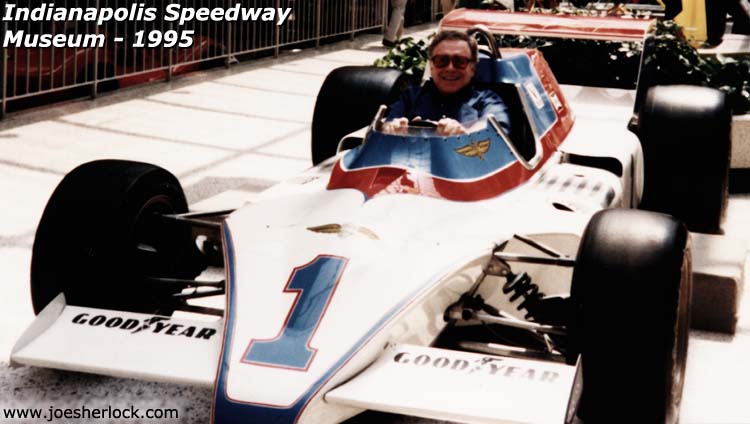
Full "flag-to-flag" coverage of the Indy 500 on network television didn't begin until 1986. Same-day, tape-delayed coverage began in 1971, with Chris Schenkel and Prep alumnus Jim McKay as hosts/announcers. Back in 1964 (the setting for this book), one either listened to the big race on the radio or paid to watch it live in select movie theaters in major cities. In '64, there was no Jim Nabors to sing 'Back Home Again In Indiana' (he did so from 1972 to 2014); Vic Damone performed the 500's signature song in 1964.
The 48th International 500-Mile Sweepstakes was held on Saturday, May 30, 1964. It is mostly remembered for the horrific fiery seven-car accident that resulted in the deaths of two excellent race car drivers, Eddie Sachs and Dave MacDonald. It was the last race won by a front-engined roadster, driven by A.J. Foyt.
'Black Noon' chronicles this dark day in the Indy 500's history. When Indy rookie Dave MacDonald came out of the fourth turn and onto the front stretch at the end of the second lap, he found his rear-engined car lifted by turbulence from two cars he was attempting to pass. MacDonald lost control and careened off the inside wall of the track, exploding into a huge fireball and sliding back into oncoming traffic. Beloved driver Eddie Sachs hit MacDonald's car broadside, causing a second explosion.
The author thoroughly researched this event and his superior writing recreated in great detail the spectacle that is the Indianapolis 500. His work was good enough to win the 2014 Dean Batchelor Award and the Motor Press Guild 'Book of the Year' prize.
The 1964 Indianapolis 500 was a dramatic turning point in automobile racing history. It was a time of changing car design, disputes over front versus rear engine placement, tire challenges, fuel disagreements and an unusual, tension-causing mix of traditional Indy roadster/sprint car drivers, stock car competitors (according to the book, most sprint racers referred to stock cars as 'taxicabs' but at least those period NASCAR racers looked like autos you'd see on the street, unlike today's decal-bedecked cartoon coupes), sports car racers and British Formula One drivers.
While there were some minor mistakes, mostly about the auto industry of the period rather that the race, the book is informative, educational and entertaining. Art Garner brings the people involved to life more than a half-century later and recreates their larger-than-life personas. Many of the people mentioned in this book - Mario Andretti, Bob Bondurant, A.J. Foyt (who won the 1964 race), Andy Granatelli, Masten Gregory, Dan Gurney, Graham Hill, Parnelli Jones, Mickey Thompson, etc. - are the folks I read about in my high school and college days in the pages of Road & Track and other car buff mags.
Verdict: Highly recommended. (posted 5/25/16, permalink)
'Originals: How Non-Conformists Move the World' by Adam Grant
The first few chapters of Grant's book were exciting and inspiring. Then the book wandered off into less-compelling and more mundane examples of non-conformity and my interest dropped sharply. Anecdotes were both uninteresting and unconvincing.
Organizational expert Donald A. Schon once said, "The difficulty with these rare geniuses is that they can be recognized only in retrospect, never in prospect. You never know for certain that your present-day tormenter, who you think is a crank, may not turn out to be another Goddard."
I still believe that most non-conformists do not change the world; they spend their days letting everyone know that they're not "part of the flock of sheep, man." I've worked at companies where non-conformists were forced out of the firm, when managers became tired of their endless bullshit and trouble-making. And the company was better for it.
Verdict: I'm not convinced of the book's premise, man. (posted 5/19/16, permalink)
'Car Crazy: The Battle for Supremacy between Ford and Olds and the Dawn of the Automobile Age' by G. Wayne Miller
This book covers early automobile history from the late 19th Century through the introduction of the Ford Model T in 1908.

The Ford versus Olds story is a bit contrived, since Oldsmobile was founded by Ransom E. Olds in 1897. In 1901, the company produced 425 curved-dash Oldsmobiles, making it the first high-volume gasoline-powered automobile manufacturer. Olds was forced out of his company by the Smith family who were the majority shareholders. Olds soon formed a new automobile company, REO (his initials). While Oldsmobile outsold Ford in earlier years, Fredric Smith's insistence on producing luxury cars lead to the downfall of the firm and its subsequent takeover by General Motors.
Henry Ford produced his first car in 1896 - the bicycle-tired Quadricycle. He started - and left - several companies over the next several years. One of them became Cadillac. Ford eventually found partners who shared his vision for lower-priced cars and eventually developed the Model T.
The book covers in detail several long distance auto trials and races, including attempts to travel coast to coast with primitive machines over primitive to non-existent roads. The tale of the 1905 cross-continent race from Manhattan to the Lewis and Clark Centennial and American Pacific Exposition is thoroughly told.
Much time is given to the fight over the Selden patent, which alleged to cover every automobile made. The patent holders demanded a royalty of $15 per car with a minimum annual payment of $5,000. They harassed both established and budding automakers.
This is a very good, 300-page, enjoyable read which covers the exciting, fiercely competitive and heroic times at the dawn of the automobile era, profiling the vehicles, the racers, the makers and the magnates.
Verdict: Recommended. (posted 5/11/16, permalink)
'Leonard: My Fifty-Year Friendship with a Remarkable Man' by William Shatner
I'm not a Trekkie. I did watch most episodes of the 'Star Trek' series when originally broadcast from 1966 to '69. And I've seen a couple of the movies but that's about it. Nevertheless, I enjoyed this book; it was a fast and easy read. Shatner is a good story-teller with a rich supply of anecdotes.
The book takes readers beyond the Spock actor to reveal the poet, photographer, stage actor, director, recovering alcoholic and family man that was Leonard Nimoy.
This book is not just about Leonard Nimoy though. There's a lot of William Shatner in it too. It struck me as odd that Shatner says that Nimoy "was his friend for five decades" but the pair were not on speaking terms at the time of Leonard's death and Shatner did not attend his funeral. Also puzzling was Shatner's own admission that he didn't know what it meant to be or to have a friend. It made me wonder why he wrote the book.
Nevertheless, Bill S. paints Leonard in a good light and I learned much about a complex, multi-talented man who was much more that the one-dimensional Vulcan. He lived long and prospered.
Verdict: Barely Recommended. (posted 5/5/16, permalink)
'Last Act: The Final Years and Emerging Legacy of Ronald Reagan' by Craig Shirley
As someone in his 73rd year, I've seen a lot of U.S. presidents come and go. In my estimation, Ronald Reagan was the greatest one in my lifetime. In the Preface of this book, the author quotes philosopher, poet, literary and cultural critic George Santayana, who once said, "History is a pack of lies about events that never happened told by people who weren't there."
Well, I was there - in a sense - I saw the positive effects of the Reagan Revolution from my own vantage point as a small business owner. In 1978, the consumer price index had gone up by 9%. In 1979, it went up 13.3%. In 1980, Jimmy Carter's last year in office, inflation had risen to 12.5%. In 1981, it dropped to 8.9% and averaged 3.6% for the remaining seven years of the Reagan presidency. Inflationary expectations, combined with monetary tightening by the Federal Reserve, caused interest rates to hit the highest levels in U.S. history. By mid-1980, the prime rate was over 20 percent! Unsecured personal loans were actually cheaper at Household Finance Corporation than small business loans were at my local banks in those days. Reagan quickly put a stop to this madness. God bless him.
The stock market took off in a recovery which continued (with the occasional hiccup) for the remainder of the 20th Century. Unemployment subsided, too. Recessions since then have been normal in scope but infrequent in nature. The dollar recovered - so much that, by the mid-1980s, the British pound was down to $1.09. And 'stagflation' disappeared from America's lexicon. It was all thanks to Ronald Reagan and his team.
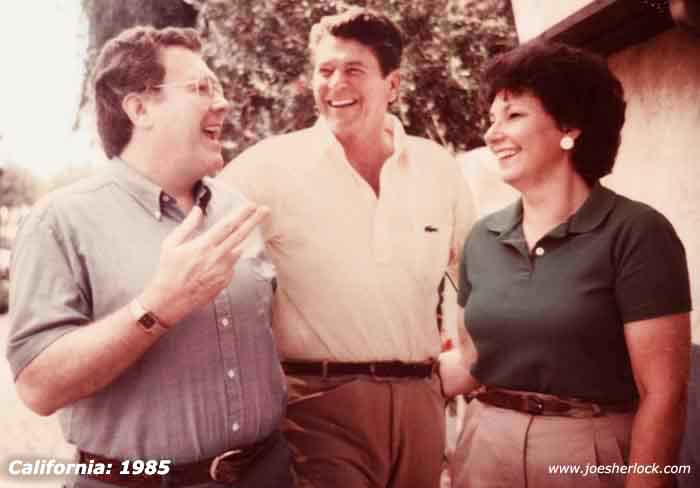
As for my small business, we employed seven full-time employees when Ronald Reagan was elected. Our average employee was being paid slightly above minimum wage. When we sold the business in 1989, we employed over 70 full-time workers at an average wage more than double the minimum wage. Reagan's rising tide lifted all boats: investors saw the value of the stock market almost triple, my employees saw their wages increase greatly and their job security assured, business owners like myself saw the value of their corporations increase greatly. During that same period, our company's sales increased more than twelve-fold.
The book provides numerous examples of liberal disdain for Reagan, even at his death, when the success of his policies was a proven fact. The establishment media, including such liberal stalwarts as the 'New York Times' and 'Washington Post' damned Reagan with the faintest of praise in its obituaries.
Well, some people just never got it. I remember one of my liberal employees carping about Reagan in 1986 or thereabouts. I pointed out that, when she was hired two years previously, the wages from her prior job had been 70% less than she was presently making. She could, in no small part, thank Reagan's supply-side economics for the boost in our business and in her paycheck. Did she want to turn back time - put Jimmy back in the White House and go back to her minimum wage job elsewhere under the high-unemployment Carter administration? Her "reply" was silence and a petulant glare. Some people never seem to get it.
Reagan was such a great president and, as a fan of The Great Communicator', fully expected to enjoy this book. Sadly, I didn't. While the book offered lots of behind-the-scene details about Reagan's last years and his magnificent funeral, I found too much annoying repetition. The author seemed to obsess over every negative press story and perceived slight to the Reagans.
There's a good, smaller book in here somewhere: Take this 500-page tome, cut out the repetitiveness, the partisan rants and the over-the-top, unnecessary trivia and you might be left with a half-decent, 250-page book.
There are many other good books about Ronald Reagan, including 'Reagan Remembered' and 'Reagan: The Life'.
Verdict: Read this at your own risk ... of boredom. (posted 4/27/16, permalink)
'These Few Precious Days: The Final Year of Jack with Jackie' by Christopher Andersen
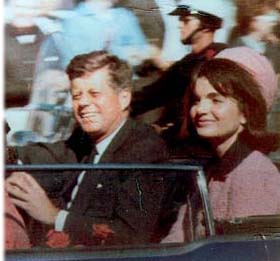 The title of this book comes from a phrase in the lyrics of the melancholy 'September Song', one of John F. Kennedy's favorites. The 'final year' subtitle is misleading; it took about half the book before the final 12 months of JFK's life began. Much of the book is a rehash of old material - not surprising since so much has been written about the Kennedys. But I did learn some tidbits: The title of this book comes from a phrase in the lyrics of the melancholy 'September Song', one of John F. Kennedy's favorites. The 'final year' subtitle is misleading; it took about half the book before the final 12 months of JFK's life began. Much of the book is a rehash of old material - not surprising since so much has been written about the Kennedys. But I did learn some tidbits:
• Despite the aura of sophistication crafted by the Kennedy's PR people, JFK used to play Elvis records as well as Chubby Checker's 'The Twist' in their White House private quarters. JFK didn't like opera or ballet and didn't know much about classical music. (Sounds like a man after my own heart.) Jackie like to dance the Hully Gully.
• Caroline had a lot of pets, including a beer-guzzling rabbit named Zsa Zsa.
• JFK's pet name for Caroline was 'Buttons'. He sometimes called John-John 'Helicopter Head', because J-J liked to spin around, imitating the blades of Marine One.
• JFK despised India's Prime Minister, Jawaharlal Nehru, referring to him as a "sanctimonious fucker ... the worst phony you've ever seen." Six foot eight U.S. Ambassador Kenneth Galbraith didn't care much for him either.
• The names of JFK's various assignations are discussed in the book. While the Marilyn Monroe affair is old news, I didn't realize that Kennedy bedded Hollywood movie stars Gene Tierney, Lee Remick and Angie Dickinson.
• JFK smoked three marijuana joints with his lover, Mary Pinchot Meyer, in the Yellow Room of the White House. Jackie was a heavy smoker, but stuck to L&M or Newport cigarettes. (My dad smoked those brands at one time or another.)
• Vaughn Meader's parody record album, 'The First Family', sold 7.5 million copies. (I think I still have a copy around here somewhere.) After the assassination, the comedian's career vanished.
This 308-page book was a fairly easy read and, if you're interested in the JFK era, I recommend it. (posted 4/21/16, permalink)
'Sinatra: The Chairman' by James Kaplan
This 992-page doorstop of a book covers Sinatra's life from his Academy Award win to his death in 1998. An earlier Kaplan work, 'Frank: The Voice', covered the 1915 to 1954 period.
There are six things that are indisputable about Frank Sinatra:
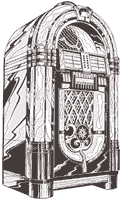 1. He was a good singer at one time. Everyone has a different timeline: some felt that he lost his voice in the early 'fifties and depended on great orchestration after that. James Lileks once wrote, "Half the songs for which he's beloved have more to do with orchestration and the fact that he was singing wistful songs at the uh-oh-my-prostate age." 1. He was a good singer at one time. Everyone has a different timeline: some felt that he lost his voice in the early 'fifties and depended on great orchestration after that. James Lileks once wrote, "Half the songs for which he's beloved have more to do with orchestration and the fact that he was singing wistful songs at the uh-oh-my-prostate age."
Others felt that, in Sinatra's middle-years, his cigarette-and-whiskey roughened vocal cords created a more mature sound. I dunno. I tend to agree with Gregory Sullivan: "Quincy (Jones) warmed up by tinkering with Sinatra, after Sinatra had blown his voice out with poor method and booze and cigarettes and putting his head in ovens over Ava Gardener and couldn't sing much anymore. Sinatra had gotten all the mileage he could from just sort of talking in a singsong way in a low register, with Nelson Riddle riding herd over the half a gross of string players sawing away behind him. Quincy coaxed one last blast of Brooklyn funk from ol' Blue Eyes' leather lungs by putting Count Basie behind him, and perhaps reminding him of what he used to be."
Your opinion may differ. The book devotes much detail to Sinatra's recordings, his recording sessions and the major players involved. It also notes that he smoked two packs of unfiltered Camels per day, as well as a bottle (or more) of Jack Daniels. And that he soothed his throat with a cup of tea with some honey in it. Despite a voice which was clearly failing by the 1980s, Frank continued to do live concerts until he was well into his 70s. His fans still attended, much like Elvis' fans still went to concerts when Elvis Presley was a fat, drugged parody of his former self.
2. The antics of the Rat Pack, led by Frank, were a lot of fun to watch or read about but you probably felt differently if you were renting the hotel suite next door and trying get some sleep. If you read this book, you'll find lots of Rat Pack stories. You'll also get an education about Skinny D'Amato and his 500 Club in Atlantic City, NJ as well as his Nevada Cal-Neva connections. Skinny rescued Frank by giving him work when his career was at its nadir. Frank repaid Skinny by appearing at the little 500 Club every year without pay. I remember how his appearances in Atlantic City practically shut down the town, creating traffic chaos within miles of the nightspot.
Kaplan wrote, "The Rat Pack was an idea, even more than it was a reality. And though Frank, Dean and Sammy were the real men, their respective myths tend, to this day, to jostle reality aside. Throw in Joey Bishop and Peter Lawford as window dressing, or ballast, and you've got a sharkskin suited, skinny-tied, chain-smoking, chain-drinking, Dionysian parade float. Watch it trundle down Main Street; cheer as it goes by. We won't see the likes of it again. Even if it wasn't quite there in the first place."
3. Name any female movie actress from the 1950s or '60s and there's probably a 40% chance that Sinatra had sex with her. Marilyn Monroe, Natalie Wood, Angie Dickinson, Jeanne Carmen (Queen of the B-Movies), Ava Gardner (he married her), Judy Garland, Mia Farrow (he married her, too), Lauren Bacall, Elizabeth Taylor - a cast of thousands, so to speak. (You'll find many more names in the book.) Fellow Rat-Packer Dean Martin once said, "When Sinatra dies, they're giving his zipper to the Smithsonian."
Frank and Ava had an on-again, off-again love affair for most of their adult lives. He always sent her an enormous bouquet of flowers for her birthday. Ava "would let the flowers sit in their vase until they died and then kept them there, long dead, for the rest of the year until the next bouquet arrived."
4. Sinatra had a bad temper and could be rude, demanding and loutish. He and various mafia thugs had formed a mutual admiration society and Frank wouldn't hesitate to have someone beat up if they crossed him. Kaplan's book discussed Frank's Cosa Nostra connections and activities in detail. As well as his bad behavior.
5. Frankie also was generous to individuals and charities. In the 1940s, Sinatra bankrolled Patsy D'Amore because Frank couldn't find any decent Italian food in LA. The sit-down restaurant is long gone but Patsy D'Amore's lives on in a LA Farmers Market stall. This legendary place serves up the closest thing to old-time New Jersey Boardwalk pizza, properly flavorful and greasy.
6. Whether you like Sinatra or not, you have to admit that he was a larger-than-life figure, known worldwide.
Here are some tidbits from the book:
• Ol' Blue Eyes hated rock-n-roll but, in the early '60s, made a record: 'Everybody's Twistin'. One could also argue that the beat-heavy 'Hey, Jealous Lover' was an early attempt at rock-n-roll (recorded in late 1956). I remember DJs promoting it as such, just as they did for Nat King Cole's 'Send For Me'.
• Frank was brilliant in 'The Manchurian Candidate'. But so was Angela Lansbury.
• Mia Farrow wanted a puppy for Christmas, but instead Frank gave Mia "a solid gold cigarette case, inscribed 'Mia, Mia. With Love, From Francis'. She kept marijuana joints in it."
• Frank Sinatra loved to get away from Los Angeles to his Palm Springs area hideaway - a 10 acre residential compound in Palm Desert.
• Frank Sinatra was a liberal Democrat who was used and thrown away by the Kennedys; he later became a Republican and a big supporter of Ronald Reagan - a man he once detested. A former girlfriend of Frank's buddy Jimmy Van Heusen said, "He (Frank) hated the guy, just hated him. We'd be at some party and, if the Reagans arrived, Frank would snap his fingers and say 'C'mon, Chester. We're leaving. I can't stand that fucking Ronnie. He's such a bore. Every time you get near the bastard he makes a speech and he never knows what he's talking about.'" Of course, Sinatra later became fast friends with Ron & Nancy and was a frequent guest at the White House.
Whether you're a Frank fan or not, I think you'll enjoy reading about the 1950s, '60s and '70s as portrayed in the book - especially the many period celebrities. The author also discusses the changes in music and culture over the years, how they affected Sinatra and how he responded to such changes.
Verdict: A lengthy book but a very good read. Recommended. (posted 4/13/16, permalink)
'Sam Phillips: The Man Who Invented Rock 'n' Roll' by Peter Guralnick
Mr. Guralnick has written extensively about music, especially rock & roll as well as rhythm and blues. His two autobiographies of Elvis Presley are considered the standards against which other Elvis books are judged. I reviewed his Sam Cooke biography earlier this year.
 Sam Phillips owned the legendary Sun Records in Memphis. He recorded what is arguably the first rock & roll record - Jackie Brentson's 'Rocket 88' in 1951. It certainly had the correct elements: it was about a car - a 1950 Oldsmobile 88 with a high-compression, overhead-valve Rocket V-8 engine - and featured Ike Turner on keyboards. Sam Phillips owned the legendary Sun Records in Memphis. He recorded what is arguably the first rock & roll record - Jackie Brentson's 'Rocket 88' in 1951. It certainly had the correct elements: it was about a car - a 1950 Oldsmobile 88 with a high-compression, overhead-valve Rocket V-8 engine - and featured Ike Turner on keyboards.
Phillips recorded legendary artists such as Johnny Cash, Carl Perkins, Roy Orbison, Charlie Rich, Howlin' Wolf, Rufus Thomas, Jerry Lee Lewis and, of course, Elvis Presley.
This meticulous 784-page tome covers the life of Phillips from his humble beginnings in an Alabama small town to his eventual success in the music industry. Phillips is portrayed as a larger-than-life, self-made man - a loner, who recorded poverty-stricken black blues artists and, eventually, poor white country boys, whose recordings would transform the face of music.
I found this book informative but it too often dove down into minute details - unnecessary tales which are boring and make for laborious reading. Phillips later years are less interesting, as he evolved into a philandering, hard-drinking blowhard.
Nevertheless, the book tells the story of the ups and downs of the early years of rock and, as such, is a very worthwhile read.
Verdct: Recommended. (posted 4/7/16, permalink)
'The Art Of The Con: The Most Notorious Fakes, Frauds, and Forgeries in the Art World' by Anthony M. Amore
I always thought that the world of fine collectible art was a little sketchy but I never realized the extent of various scams until I read this book. I was especially disturbed by the brazen scams especially those conducted on eBay and other e-commerce sites.
The various stories would have been far more interesting had the author abandoned his Joe Fridayesque 'Just the facts, Ma'am' writing style. Scoundrels are usually interesting and multifaceted characters - not so in Amore's tome. The writing was dry and the book was boring in many spots. The author is not a good storyteller.
Verdict: Meh. (posted 3/30/16, permalink)
'The Triumph Of William McKinley: Why the Election of 1896 Still Matters' by Karl Rove
This dull-as-dishwater tome is 496 wasted pages. Its political lessons could have been thoroughly presented in a 1,500-word magazine article.
Verdict: Don't bother. (posted 3/24/16, permalink)
'I Never Knew That About Ireland' by Christopher Winn
Author Winn writes about interesting places and people in Ireland. He covers the Republic as well as the North. He provides insight about heritage, memories, and monuments that have shaped each county in Ireland.
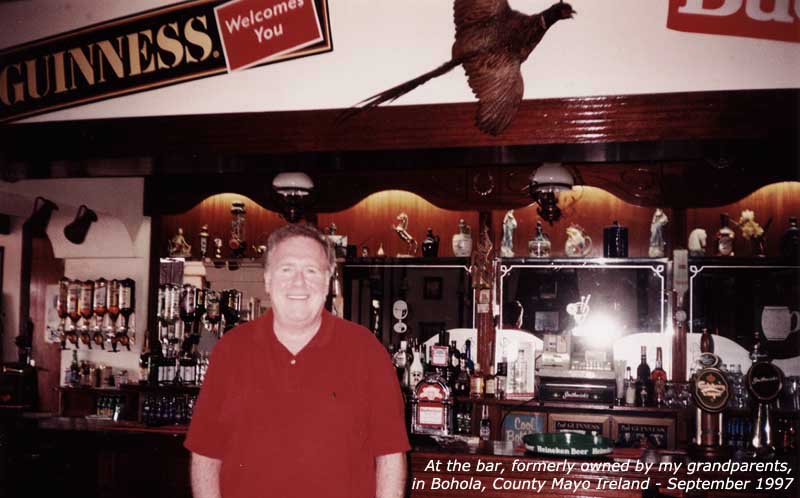
Although I've read several books about the Emerald Isle and visited Ireland twice, Winn's book is full of interesting tidbits that I never knew about:
• Flavored potato chips were invented by Dubliner Joe Murphy in 1954.
• The world's first guided missile was invented by Louis Brennan who was born in Castlebar in 1852.
• The infamous Lady Betty, originally from Kerry, was the executioner at the Roscommon Jail. Sentenced to be hanged for killing her son, the executioner called in sick on the day she was to be hanged. Betty volunteered to take his place and execute the other prisoners in return for her own pardon. When the hangman died, Betty was made official executioner. She was a cruel woman and tales abound "of her bloodthirsty rituals and cackling laughter as she sent another poor soul to his doom. Lady Betty died in 1807 and her name is still spoken in whispers in Roscommon Town."
• St. Valentine, patron saint of lovers, is buried in Dublin's Whitefriars St. Carmelite Church. Although Valentine was beaten to death in Rome in 269; Pope Gregory XVI presented Valentine's bones to the founder of this Dublin parish.
• 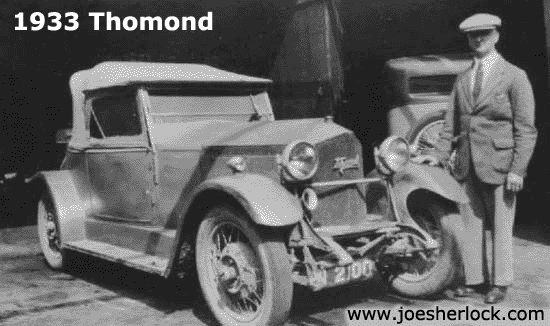 The first car ever made in the Irish Free State was the Thomond. Only four were built in Dublin between 1925 and 1933. There are no known remains of any today. The first car ever made in the Irish Free State was the Thomond. Only four were built in Dublin between 1925 and 1933. There are no known remains of any today.
• Caibre, the first MGM lion, was born at the Dublin Zoo.
• In Cork, the Shandon Steeple clock is "known as 'the four-faced liar' due to its habit of showing a slightly different time on each face."
• John Tyndall of Leighlinbridge was the self-taught physicist who developed the first explanation for why the sky is blue. He also invented the modern foghorn.
• The Butler family was well-know in Kilkenny City. But when British King Edward VII visited their home, Kilkenny Castle, in 1904, "he asked who all the people lining up to meet him were. "They're the Butlers," came the reply." "Well, why aren't they serving the bloody drinks then?" exclaimed the confused monarch.
• William Parsons of Leinster experimented with steam-powered carriages on the grounds of Birr Castle. In 1869, his cousin, Mary Ward, was thrown from one of the contraptions and died. She became Ireland's first motoring fatality.
• Dorsey Island, "off the tip of the Beara Peninsula, is connected to the mainland by Ireland's only cable car, licensed to carry three passengers and one cow."
• The word 'whiskey' comes from the Gaelic 'uisce beatha', meaning 'water of life'.
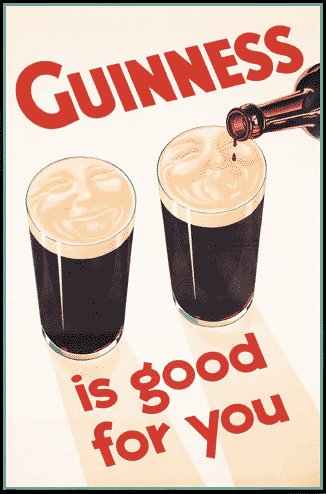
• In 1759, Arthur Guinness signed a 9,000-year lease on the land under the present site of the Guinness Brewery at St. James' Gate in Dublin.
• Lillian Bland of County Antrim, was the first woman in the world to build and fly an airplane. "In 1910, her biplane, the Mayfly, took off from Carnmoney Hill and flew for a quarter-mile, with Lillian feeding the engine whiskey through her aunt's old car-trumpet."
• New York's famous Coney Island is named after the Coney Island, one mile out in Lough Neagh off Maghery in County Armagh.
For anyone of Irish descent, or interested in the Irish and Ireland, this book is a fascinating read.
Verdict: Highly recommended. (posted 3/16/16, permalink)
'Cheney One On One: A Candid Conversation with America's Most Controversial Statesman' by James Rosen
In late 2014, Fox News reporter James Rosen sat down with former vice-president Cheney for 10 hours of interviews, conducted over a three days.
While I found parts of the book interesting and informative, the book was in a Q&A transcript format which was difficult to read and sometimes boring. Too often, Rosen would ask a well-crafted three or four sentence question, only to receive a taciturn answer from Mr. Cheney, such as "Mm-hmm", "Yeah." Or, "Right." Or, "No."
Nevertheless the book offered some fascinating insights into Cheney's oft-complicated with President George W. Bush, former Secretary of State Condoleezza Rice and others. It also corrects the left's misrepresented caricature of Cheney as Darth Vader. Instead, it show him to be a thinking man's conservative and an experienced Washington insider who knew how to get things done.
Asked about Barack Obama, Cheney had much to say including "I look at Barack Obama and see the worst president in my lifetime without question - and that's saying something. I used to have significant criticism of Jimmy Carter but, you know, compared to Barack Obama and the damage he's done to the nation, it's a tragedy, a real tragedy and we are going to pay a hell of a price just trying to dig out from under his presidency."
During the Bush administration, North Korea denied that they had a uranium-based nuclear enrichment program and sent a letter confirming it. Cheney reported, "There were traces of highly enriched uranium on the paper they used to respond to us. That was pretty conclusive evidence (chuckles) that they were lying through their teeth!"
Recommendation: I think Cheney's 'In My Time: A Personal and Political Memoir', published in 2011, is a better choice. (posted 3/9/16, permalink)
'The Devil's In The Cows' by Gregory Sullivan
This 150 page (more or less) book contains 37 quirky short stories, written by Gregory Sullivan, proprietor of the Sippican Cottage blog. The stories range from humorous, to ironic, to depressing, to startling - each one packs a literary wallop. Words are carefully chosen, clever phrases are woven in at just the right spots. Each story stands on its own and is less than 1,000 words. I'm told that such short stories are now referred to as 'flash fiction'.
I would say that this book was an easy read except that many of the stories made me stop and think a bit - a good thing.
Verdict: Recommended. (posted 2/29/16, permalink)
'How To Fail At Almost Everything And Still Win Big: Kind of the Story of My Life' by Scott Adams
The author is the creator of the oft-hilarious 'Dilbert' comic strip plus other ventures - successful and not.

This book is about how not to fail and has some valuable business advice mixed with advice which is less useful. Scott claims that "goals are for losers?" Huh? Reading further, it's obvious that he means goals without an action plan to back them up. In my plastic manufacturing business, we used goals - with stated completion dates - to grow our business, but every goal was backed up by a list of specific actions to be taken; there was a stated completion date for each action.
Scott uses 'systems', instead of goals. That means something completely different to me and to many others in business. We had systems in our business - instructions for repetitive work, job descriptions, employee performance measurement and the like. Systems, to me, are ways to do stuff - consistently and repetitively. Scott uses different semantics than many in the business world, which can be confusing.
Too much of the book promotes diet and exercise as a way to success. I disagree, Scott. In my career, I met lots of overweight, chain-smoking, carnivores who had wildly successful businesses. (Mr. Adams is a vegetarian.)
While the book has some humorous sections, as it progresses, the amount of filler and nonsense increases exponentially.
Verdict: There are far better business books out there. (posted 2/25/16, permalink)
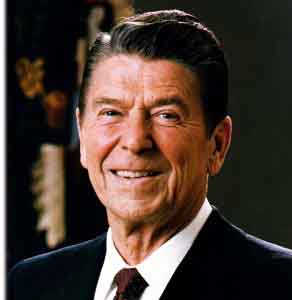 'Reagan Remembered' edited by Gilbert A. Robinson 'Reagan Remembered' edited by Gilbert A. Robinson
This book contains stories and memories from over 80 major appointees of President Ronald Reagan. Contributors included former President George H.W. Bush, Colin Powell, Elizabeth Dole, Steve Forbes, James Baker III, George Shultz, Art Laffler and Ed Meese.
The stories are personal and demonstrate the remarkable humor, courtesy, charm of the late president and his great sense of humor. The book also had lots of tales about his determination and firmness with Russian leaders that eventually brought an end to the Cold War with the Soviet Union.
Ronald Reagan's last public communication was a handwritten letter in 1994, announcing that he had Alzheimer's disease. An excerpt:
"Let me thank you, the American people, for giving me the great honor of allowing me to serve as your President. When the Lord calls me home ... I will leave with the greatest love for this country of ours and eternal optimism for its future. ... I know that, for America, there will always be a bright new dawn ahead. Thank you, my friends. May God always bless you."
A class act, even in the twilight of his life.
Most of the memories were ones I had never heard before. Even though I have been a long-time fan of President Reagan, I was amazed and impressed by the new material in this tome.
Verdict: Highly recommended. (posted 2/17/16, permalink)
'Rising To The Challenge: My Leadership Journey' by Carly Fiorina
Carly Fiorina was a 2016 Republican presidential candidate who failed to catch fire with primary voters, although she made some memorable statements - especially about Hillary Clinton's shortcomings. She dropped out of the race on February 10, 2016.
This short book - 208 pages - was an easy read and was obviously written to help boost her profile and support her candidacy.
In 1980, Fiorina started at AT&T as a management trainee and rose through the ranks to become the company's first female executive officer, helped by her second husband who was an exec at AT&T. She ran Hewlett-Packard as CEO for several years. Her critics say she ran it into the ground. She engineered the HP-Compaq merger (then the largest technology sector merger in history), of which competitor Dell Computer's CEO Michael Dell quipped, "The Compaq merger was the best thing that ever happened to Dell."
Carly was eventually fired but walked away with a $20-plus million severance package from HP In 2010, she ran for California U.S. Senator against incumbent Barbara Boxer but her campaign was hindered when Fiorina was diagnosed with stage II breast cancer and subjected to debilitation sessions of radiation and chemotherapy. She was also still grieving for her step-daughter, who died in 2009 from drug addiction. Fiorina ultimately lost the election to Boxer.
This is Carly's second book. It was interesting to read and one must admire her strength and perseverance in the face of adversity. The book is a bit self-serving and light on details of how she would move America forward as president. Nevertheless, she came across a much more authentic person than Hillary. If you're interested in Fiorina's story, her philosophy and her side of the HP saga, you'll find this book worthwhile. (posted 2/11/16, permalink)
'The Time Of Our Lives: Collected Writings' by Peggy Noonan
This book consists of the best of Noonan's columns covering the past 20+ years. Peggy always makes for a good read. Her writing is breezy yet exquisite. And often profound. Even if you disagree with her, she gets her points across. She adroitly covers America - our politics, our tragedies (several chapters cover 9/11), our culture and our times. While there is much about politics, especially the Reagan years (she was a White House speechwriter in those days), there are many stories about character - good and bad - covering the well-known, the glitterati, as well as everyday people.
You can read chapters at random because each one stands on its own merits.
Verdict: A great read. Highly Recommended. (posted 2/3/16, permalink)
'Dream Boogie: The Triumph of Sam Cooke' by Peter Guralnick
 Author Guralnick has written a big, thick, exhaustingly thorough book about the legendary soul singer, Sam Cooke. Mr. Guralnick has written extensively about music, especially rock and roll and rhythm and blues. His two autobiographies of Elvis Presley are considered the standard against which other Elvis books are judged. Author Guralnick has written a big, thick, exhaustingly thorough book about the legendary soul singer, Sam Cooke. Mr. Guralnick has written extensively about music, especially rock and roll and rhythm and blues. His two autobiographies of Elvis Presley are considered the standard against which other Elvis books are judged.
Sam Cooke was one of the most influential singers and songwriters of the 1950s and '60s. His pioneering contributions to soul music contributed to the rise of Aretha Franklin, Bobby Womack, Al Green, Curtis Mayfield, Stevie Wonder, Marvin Gaye, Billy Preston and popularized the likes of Otis Redding and James Brown. In 1964, he died tragically - shot by the manager of a seedy LA motel. After an inquest, the courts ruled Cooke's death to be a justifiable homicide. Since that time, the circumstances of his death have been called into question by Cooke's family and his wide circle of friends and acquaintances. Sam Cook was only 33 when he died.
The book captures the era, when the U.S. was torn with the injustice of racial inequality and outright hate and bigotry - especially in the South where Cook often performed. In the book, the supporting cast looms large - including such icons as Martin Luther King Jr., Malcolm X, James Brown, Harry Belafonte, Aretha Franklin, Fidel Castro, The Beatles, Sonny and Cher, Bob Dylan and a young Jimi Hendrix.
Verdict: Highly recommended. (posted 1/28/16, permalink)
 'Car Wars: The Rise, the Fall, and the Resurgence of the Electric Car' by John J. Fialka 'Car Wars: The Rise, the Fall, and the Resurgence of the Electric Car' by John J. Fialka
The author is not a car guy but does manage to present a decent history of the electric car. The problems begin when he ventures into the realm of replacement powerplants for the internal combustion engine.
In order to enjoy this book, you must:
1.) believe that global warming is a genuine threat. (I don't.)
2.) be open to the practical concept of wide-spread use of solar-power. (I'm not) ... and
3.) be blind to the fact that all-electric vehicles draw most of there energy from today's powerplants, essentially making them coal-powered vehicles.
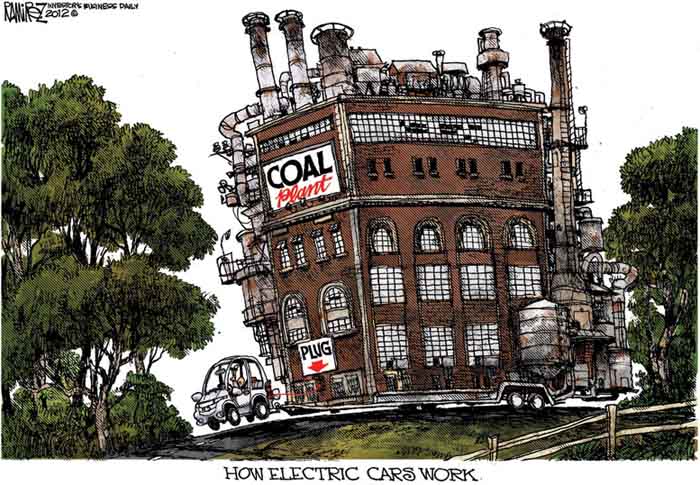
Hybrid cars, while expensive (and with payback periods of more than five years - even for the best of them), have proven themselves, especially the Toyota Prius. More exotic vehicles such as the all-electric Tesla and various limited-production hydrogen vehicles are, as yet, unproven and lack the infrastructure (filling stations/rapid charging stations) to make them practical.
I don't believe that the internal combustion engine will be around forever; however, I think that it has a lot of life left in it and will not be easily displaced by "disruptive technologies." The author feels otherwise, remarking that we "are watching the start of a trillion dollar, worldwide race to see who will dominate one of the biggest commercial upheavals of the 21st century."
Verdict: Easy to read; hard to stomach. (posted 1/20/16, permalink)
'Golden Legacy: How Golden Books Won Children's Hearts, Changed Publishing Forever, and Became An American Icon Along the Way' by Leonard S. Marcus
The printing business is mostly a job shop operation. Sales calls are made, work is solicited, jobs are quoted and, if the bid is successful, the printing - flyers, brochures, posters or whatnot - is run through the shop and shipped. Then, the shop runs out of work, so more sales calls must be made to feed the presses. It is a never-ending process and many job shops - printers, toolmakers, custom cabinet shops, plastic fabricators and the like - live a hand-to-mouth existence.
In 1907, financially-troubled West Side Printing Co. of Racine, Wisconsin - a job shop, was purchased by its bookkeeper, Edward Wadewitz. The ambitious new owner pounded the pavements in search of business and built the firm into a large and profitable concern. In 1916, the company was stuck with a printing job - a large quantity of bound children's books - made for a customer who couldn't pay. The printer, now called Western Printing and Lithography Co., fell backwards into the proprietary book publishing business.
Over the years, the firm expanded their catalog of book offerings - introducing paperback Big Little Books and obtaining licensing agreements with well-known comic strips, as well as Disney - and, in 1942, introduced Little Golden Books. The first print run - an optimistic 600,000 copies - sold out almost immediately. When the wartime paper restrictions were lifted, five million Golden Books were sold in 1947.
I grew up surrounded by Golden Books; it was how I learned to read. My wife recalls her Friday treat of selecting a new Golden Book at the Penn Fruit supermarket. Golden Books were sold in unusual places - where moms shopped - the notions section of the five-and-dime store, supermarkets, etc. Many traditional book stores snubbed the Golden Books because - at 25¢ - they were "too cheap," although they were sturdy, well-written accompanied by exceptional illustrations. What the bookstores meant was that Golden Books made the stores normal $2.00 hardback books look overpriced.
The titles were many and some became legendary: 'The Taxi That Hurried', 'The Poky Little Puppy', 'The Little Red Hen' and many more. These were books read to us by our mothers until we could read them ourselves; they are the same books we read to our children.
Golden Legacy is a lively success story of a company, its product line, the talented writers and artists who produced books and the clever mavericks who cut novel marketing deals marketed to keep moving the merchandise. The book includes a wonderful selection of archival photos and artwork that will evoke pleasant memories for those of us who grew up with Golden Books.
Marcus has spun and interesting and captivating tale.
Verdict: Highly recommended. (posted 1/13/16, permalink)
'Motorama: GM's Legendary Show & Concept Cars' by David W. Temple
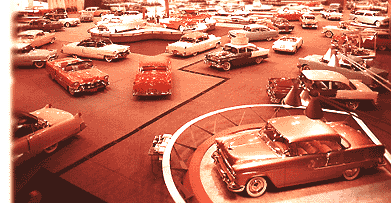 In the early postwar years, General Motors was an unstoppable force. In those days, GM had over 50% automotive market share in the U.S. Its Electro-Motive Division was the foremost producer of diesel locomotives. Its Frigidare Division was a household name and its washers, dryers and refrigerators could be found in homes across the U.S. In the early postwar years, General Motors was an unstoppable force. In those days, GM had over 50% automotive market share in the U.S. Its Electro-Motive Division was the foremost producer of diesel locomotives. Its Frigidare Division was a household name and its washers, dryers and refrigerators could be found in homes across the U.S.
To showcase its automotive might, General Motors presented Transportation Unlimited in 1949. It was the precursor to the famous Motorama extravaganzas and was open to the public.
The Motoramas began in 1950, ending in 1961. They were spectacular product showcases and usually included GM's latest Dream Cars. Typical sites for these public shows were the ballroom of the Waldorf-Astoria hotel in New York and the Pan Pacific auditorium in Los Angeles. The displays were elaborate, with animated displays and cutaways, elegant female models and, sometimes, song & dance routines.
Public interest in GM's offerings was so great that, from 11:30 am to 1:00 pm on January 21, 1953, over 12,000 visitors passed through the Waldorf Motorama exhibit, totally ignoring the televised swearing-in of President Dwight D. Eisenhower. Incidentally, Ike rode in a white '53 Cadillac Eldorado convertible in Washington's post-inaugural parade.
There have been several book published on GM's Dream Cars and on the Motoramas. This is by far the best one. Author Temple has thoroughly researched the subject and has provided details not found elsewhere. I learned a number of new things: There were at least two Corvette Nomads produced. Two Pontiac Bonneville Special two-seat sports cars were made. At least four Oldsmobile F88 concept cars were constructed. The Firebird I turbine car was quite the beast to handle, it had frightening mid-range acceleration and was involved in at least one crash. Four examples of the 1953 Cadillac LeMans two-seat sportster were made and two were later customized and updated. Many of the show cars were repainted for different appearances at various shows. Concept cars were often repainted and/or reupholstered for Canadian shows. And not all of the Motorama cars were runners - some had no working powertrains.
The book is profusely illustrated and included photos I had never seen before. Many of the technical features of the experimental cars are discussed in detail.
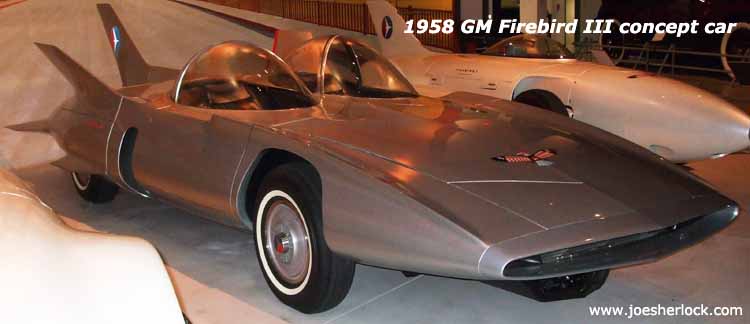
For people like me who grew up during the days of spectacular auto shows and dream cars, the book offers a memorable retrospective of this unique era in American automotive history.
Verdict: Highly Recommended. (posted 1/4/16, permalink)
More book reviews are posted here.
Other Pages Of Interest
copyright 2016 - Joseph M. Sherlock - All applicable rights reserved
Disclaimer
The facts presented in this blog are based on my best guesses and my substantially faulty geezer memory. The opinions expressed herein are strictly those of the author and are protected by the U.S. Constitution. Probably.
Spelling, punctuation and syntax errors are cheerfully repaired when I find them; grudgingly fixed when you do.
If I have slandered any brands of automobiles, either expressly or inadvertently, they're most likely crap cars and deserve it. Automobile manufacturers should be aware that they always have the option of trying to change my mind by providing me with vehicles to test drive.
If I have slandered any people or corporations in this blog, either expressly or inadvertently, they should buy me strong drinks (and an expensive meal) and try to prove to me that they're not the jerks I've portrayed them to be. If you're buying, I'm willing to listen.
Don't be shy - try a bribe. It might help.
|
|